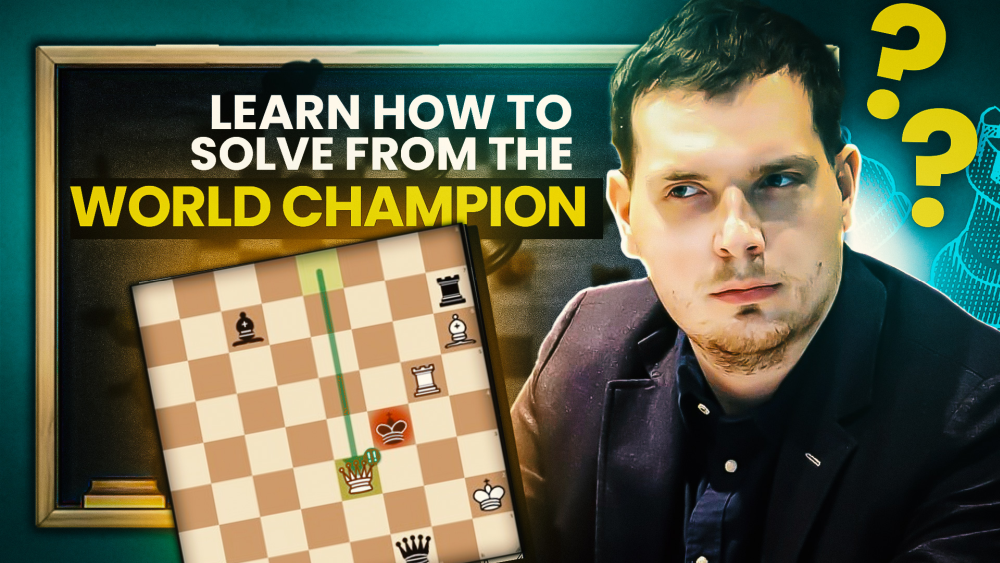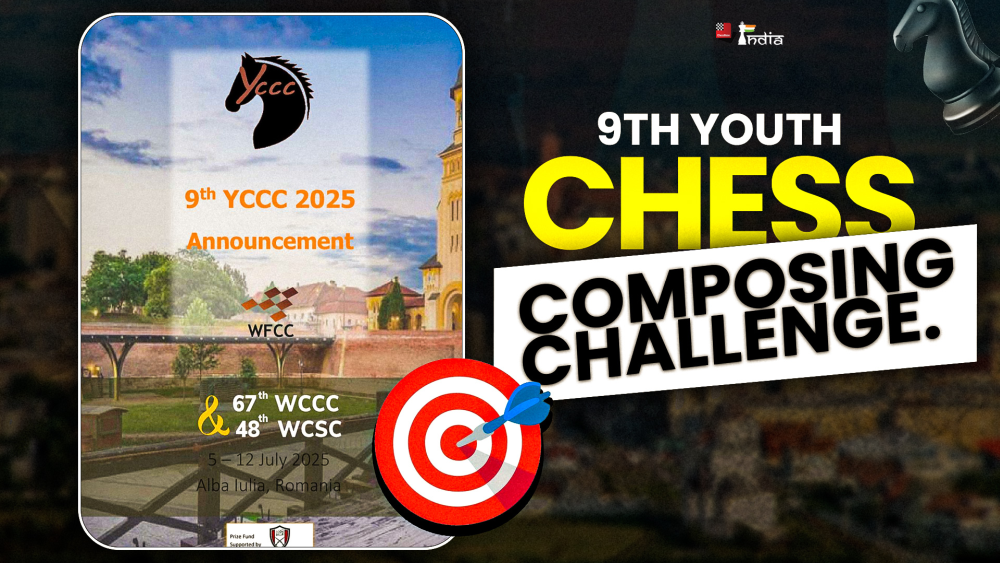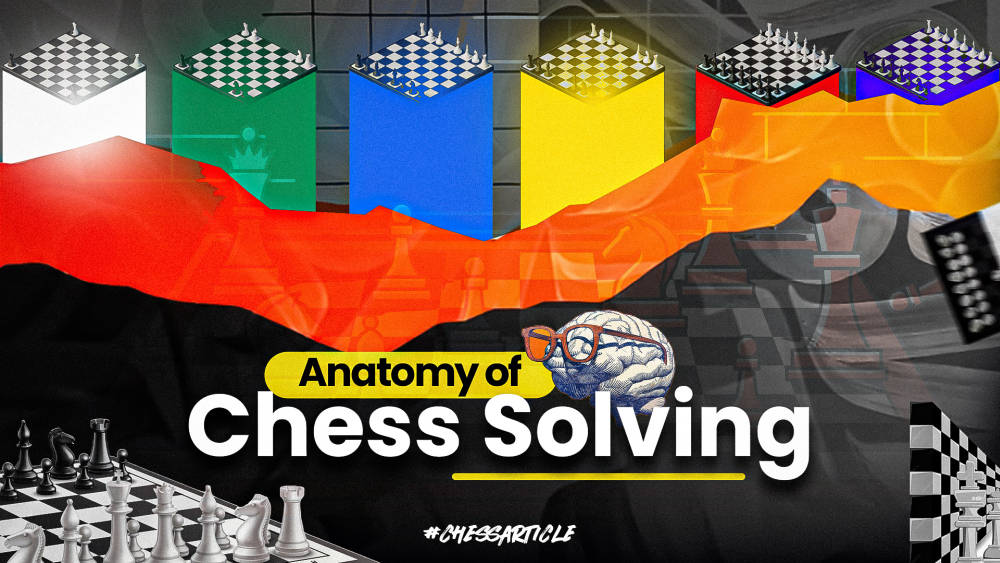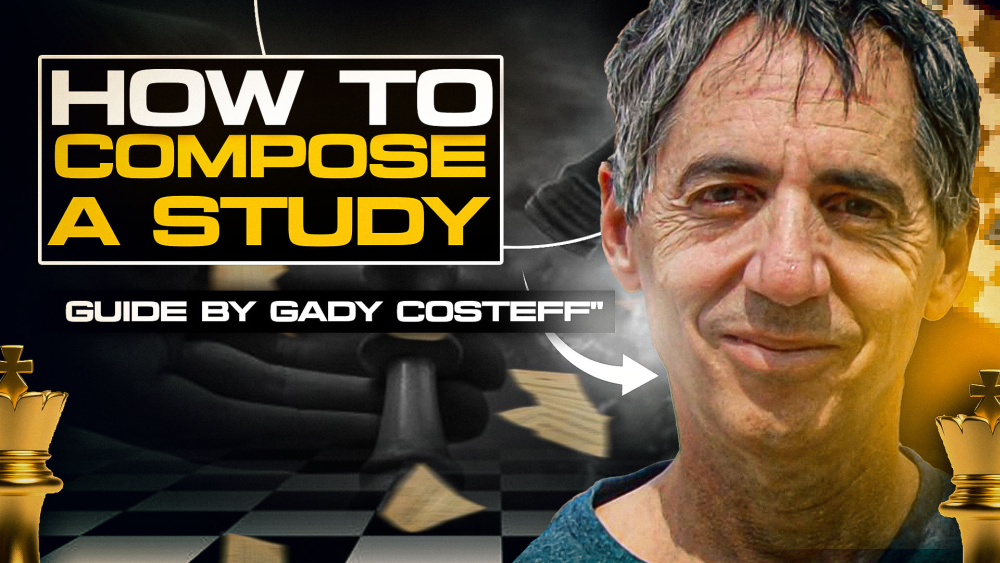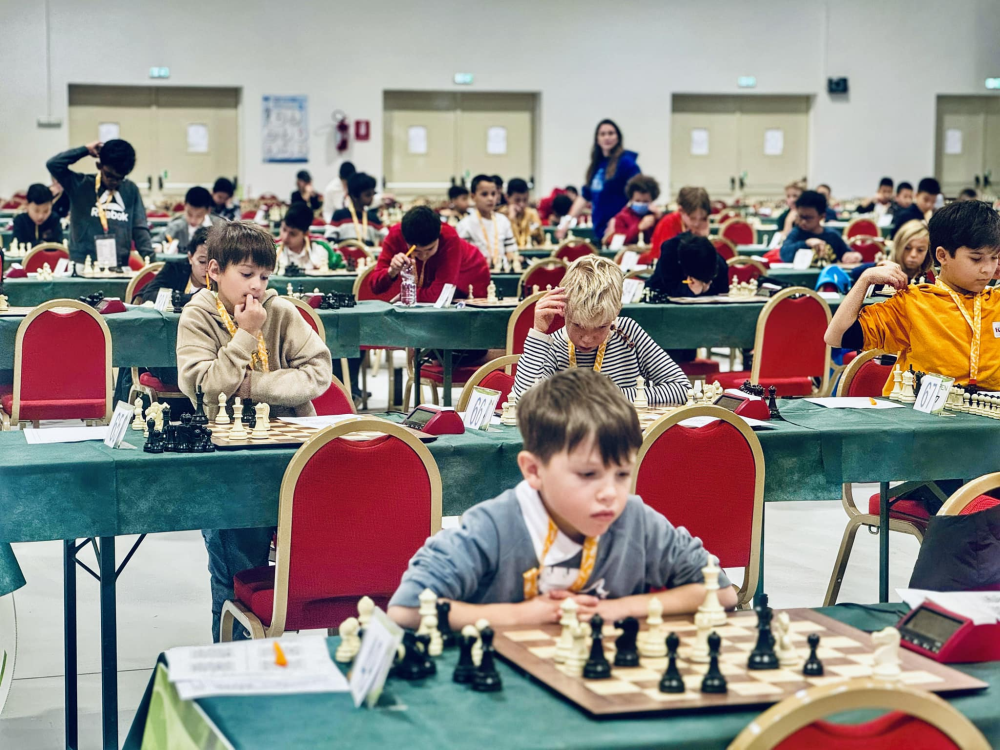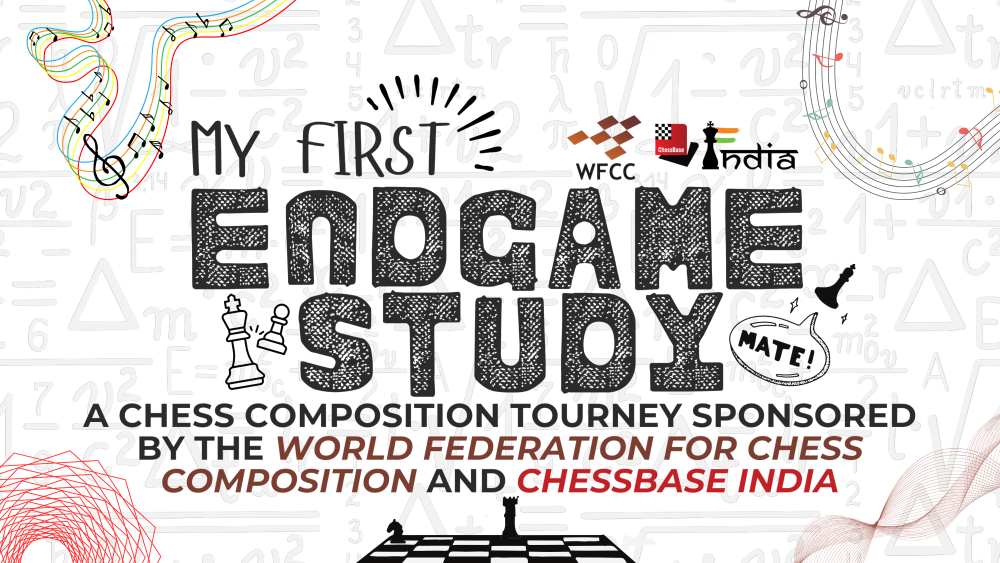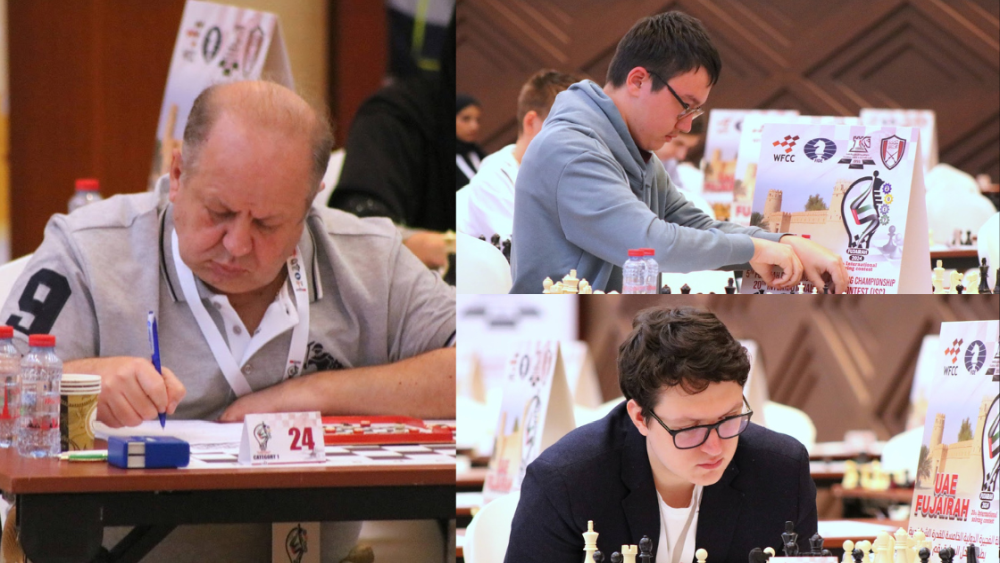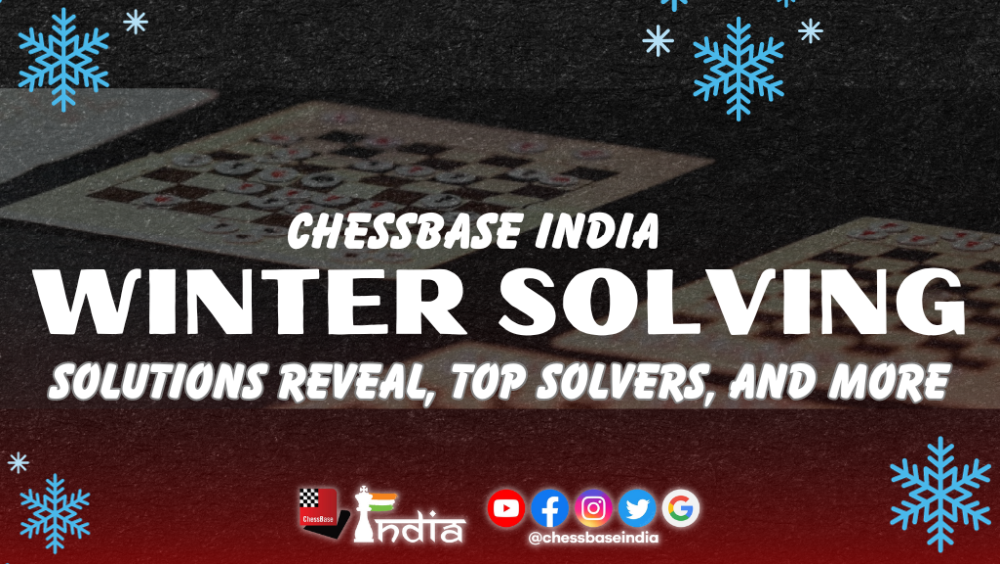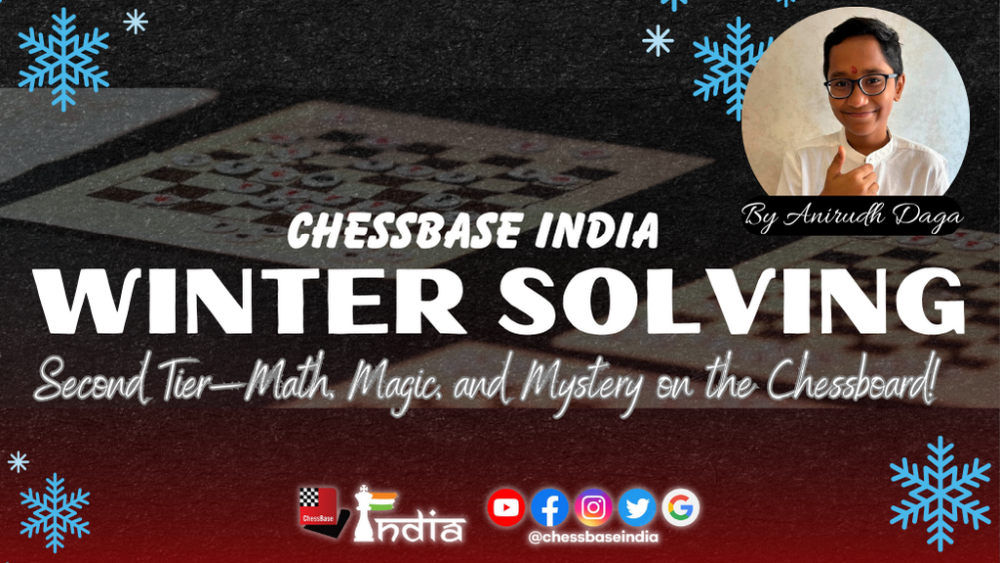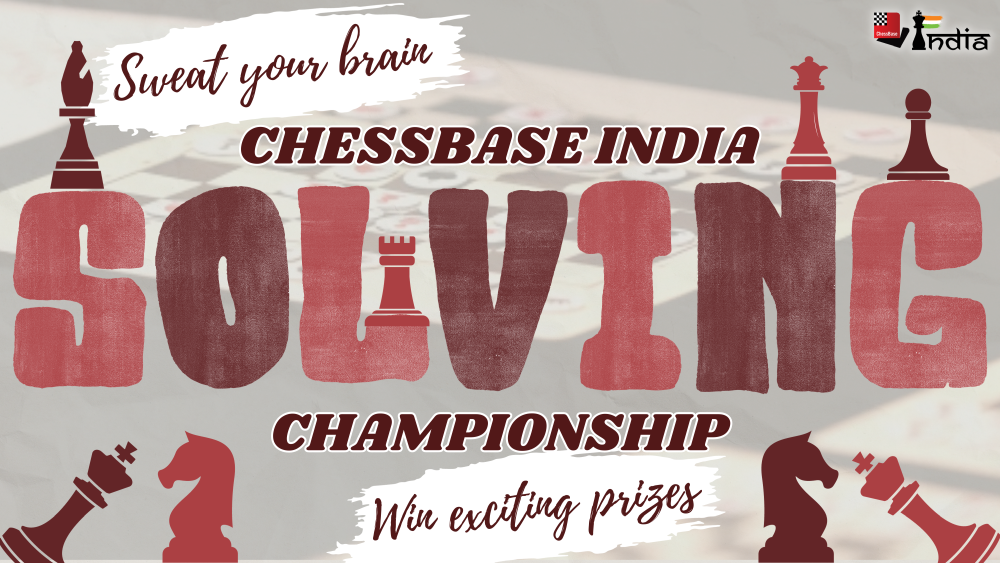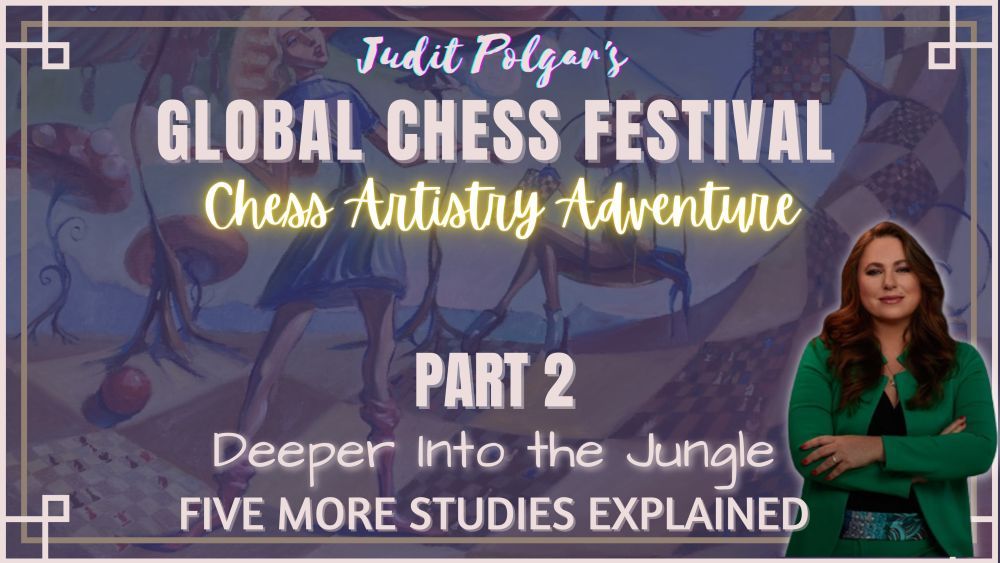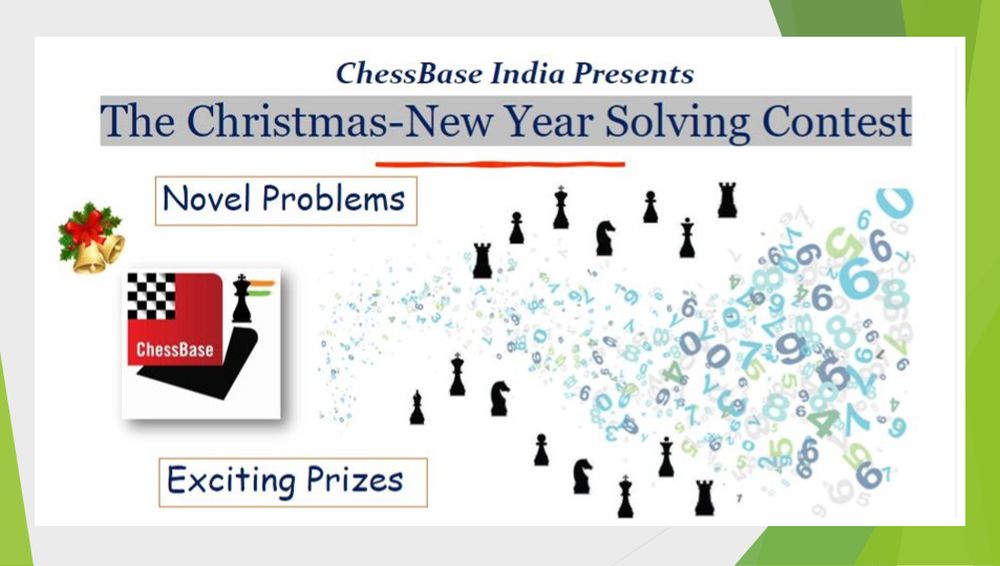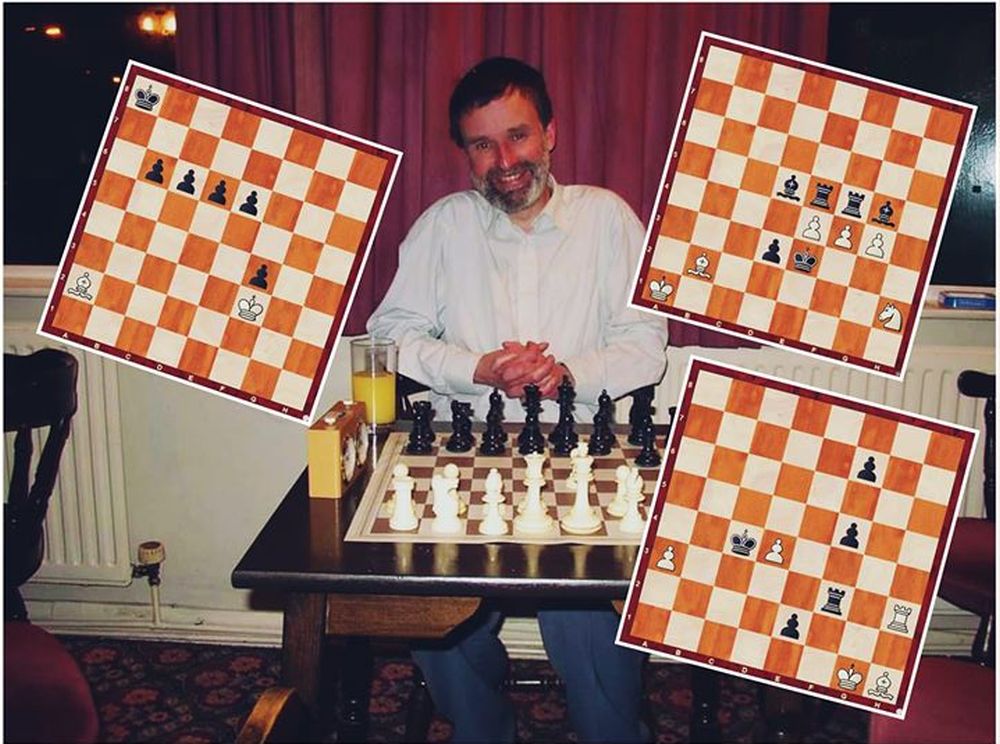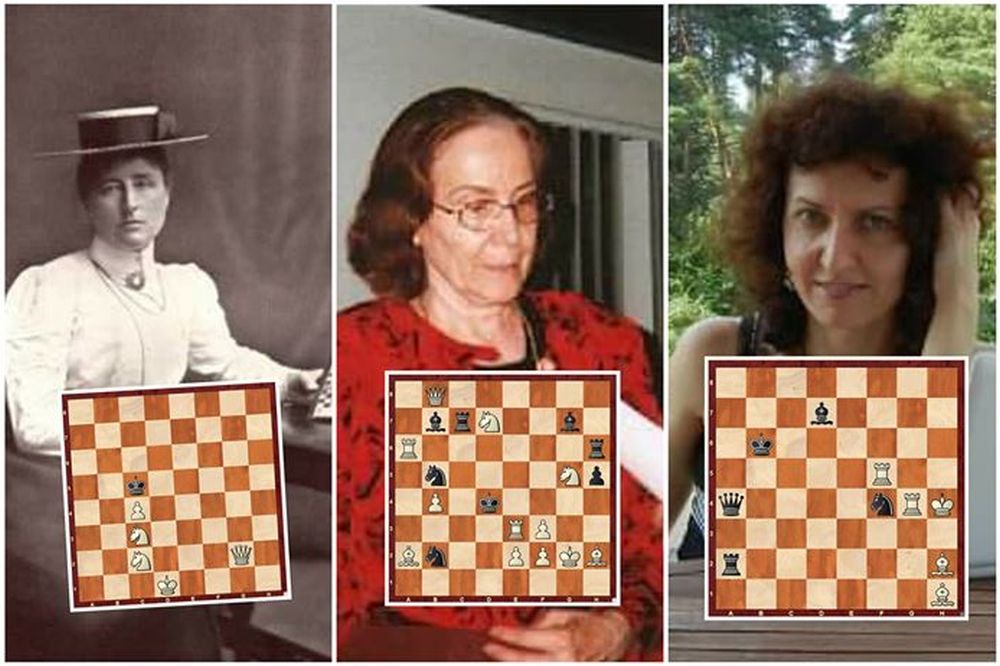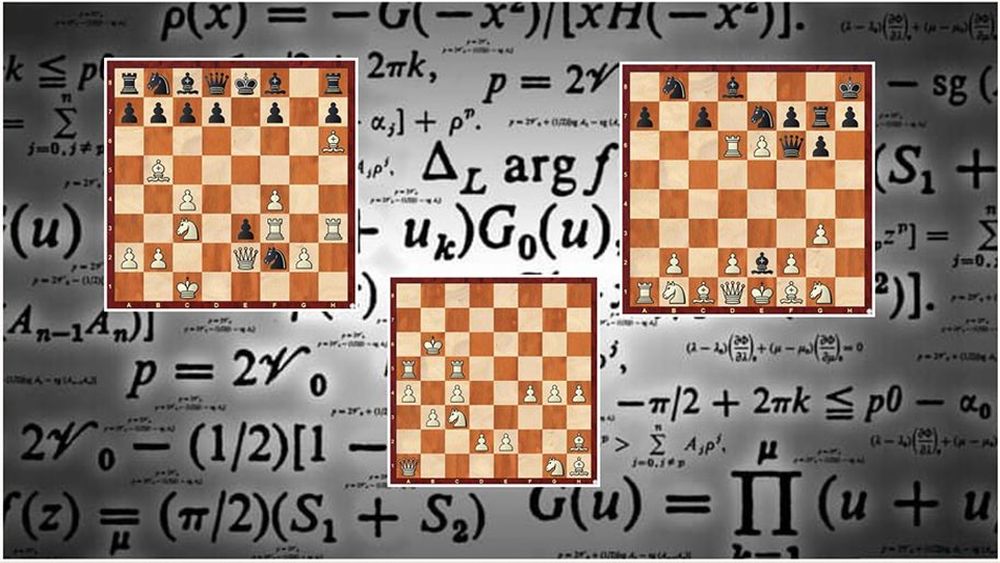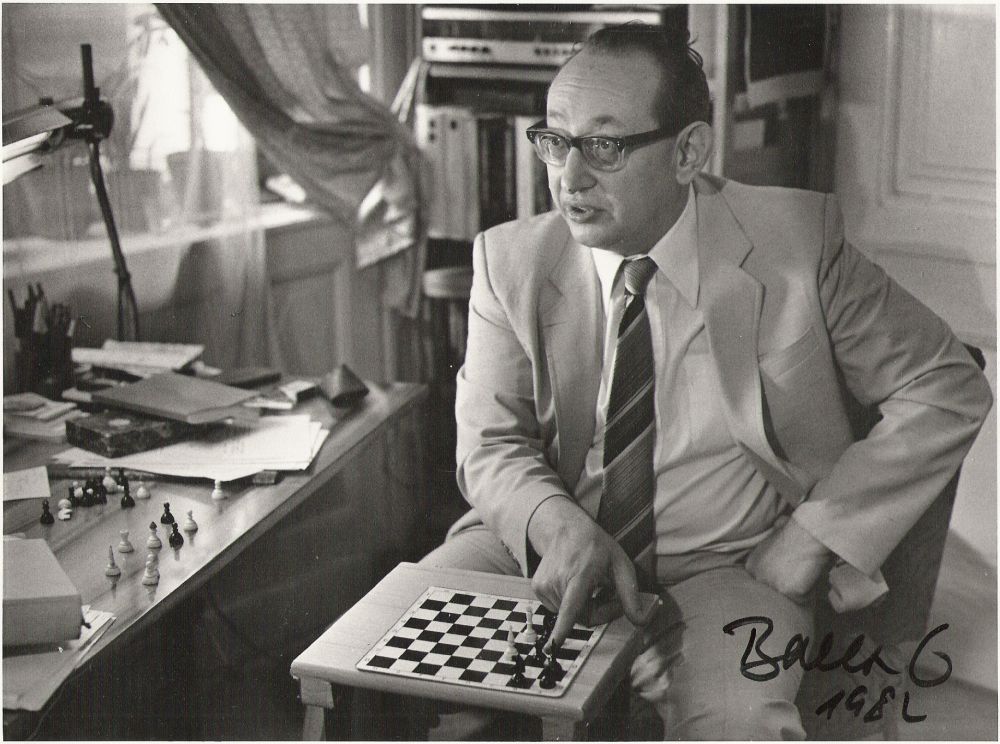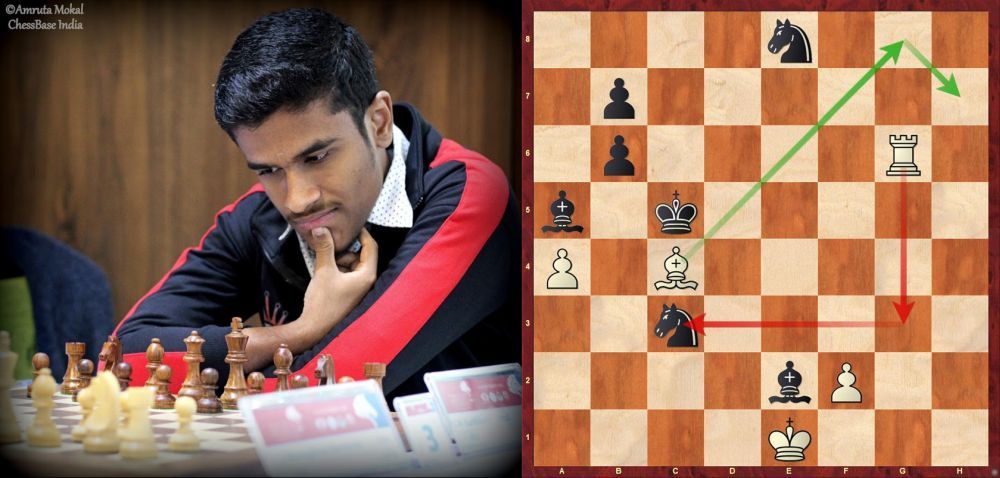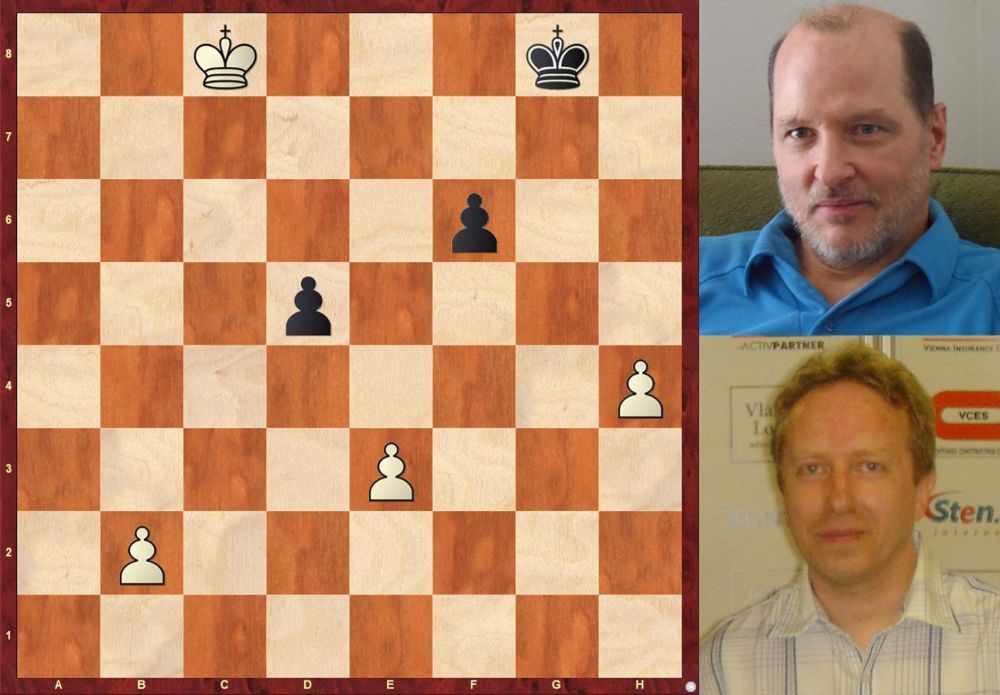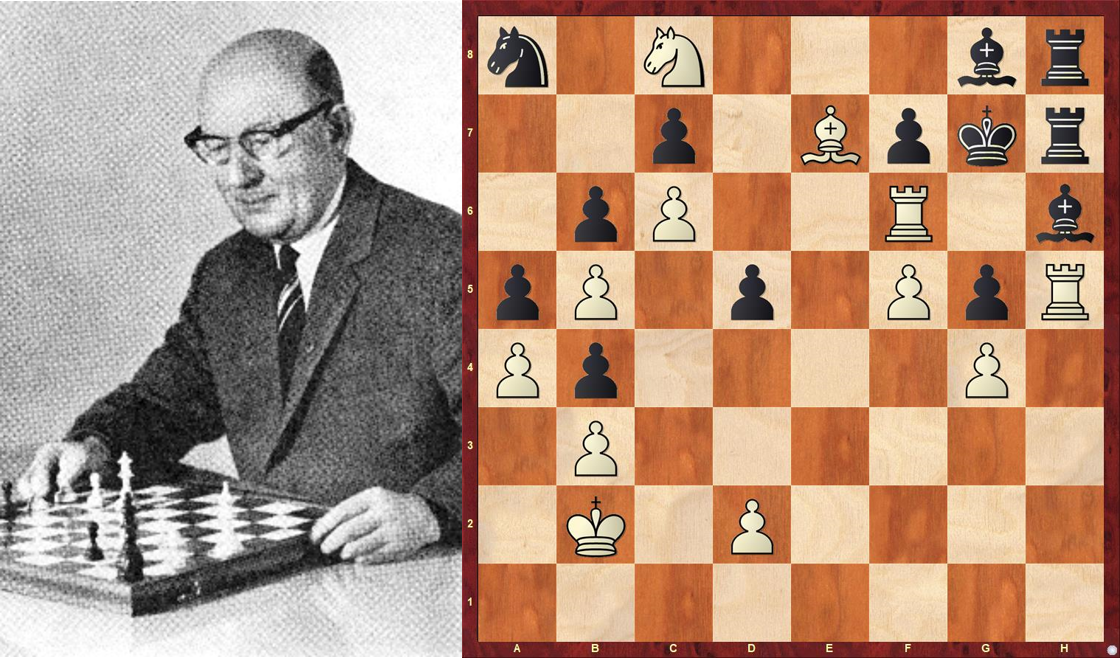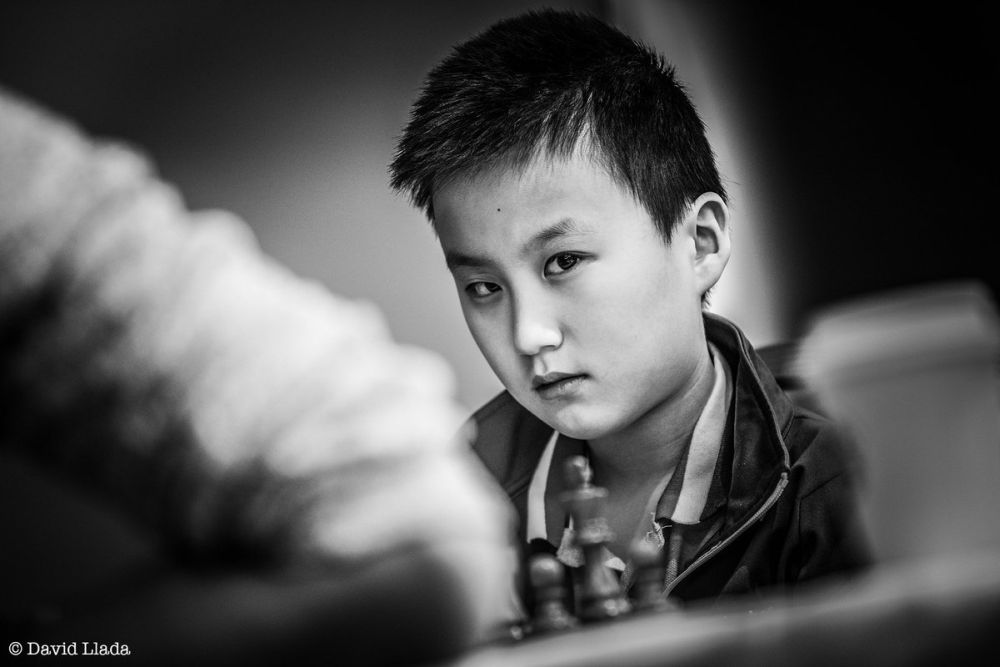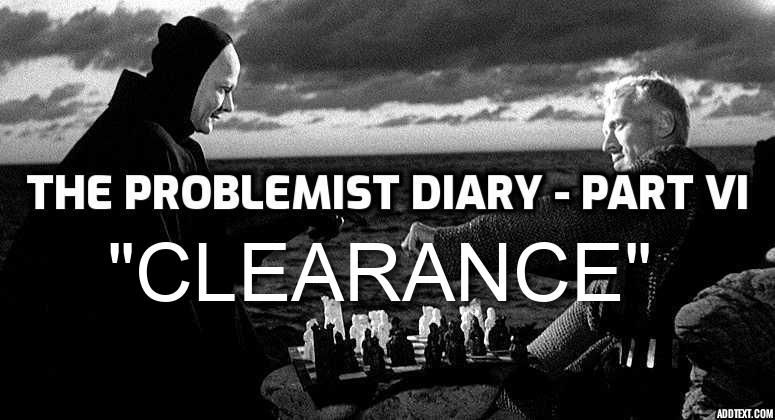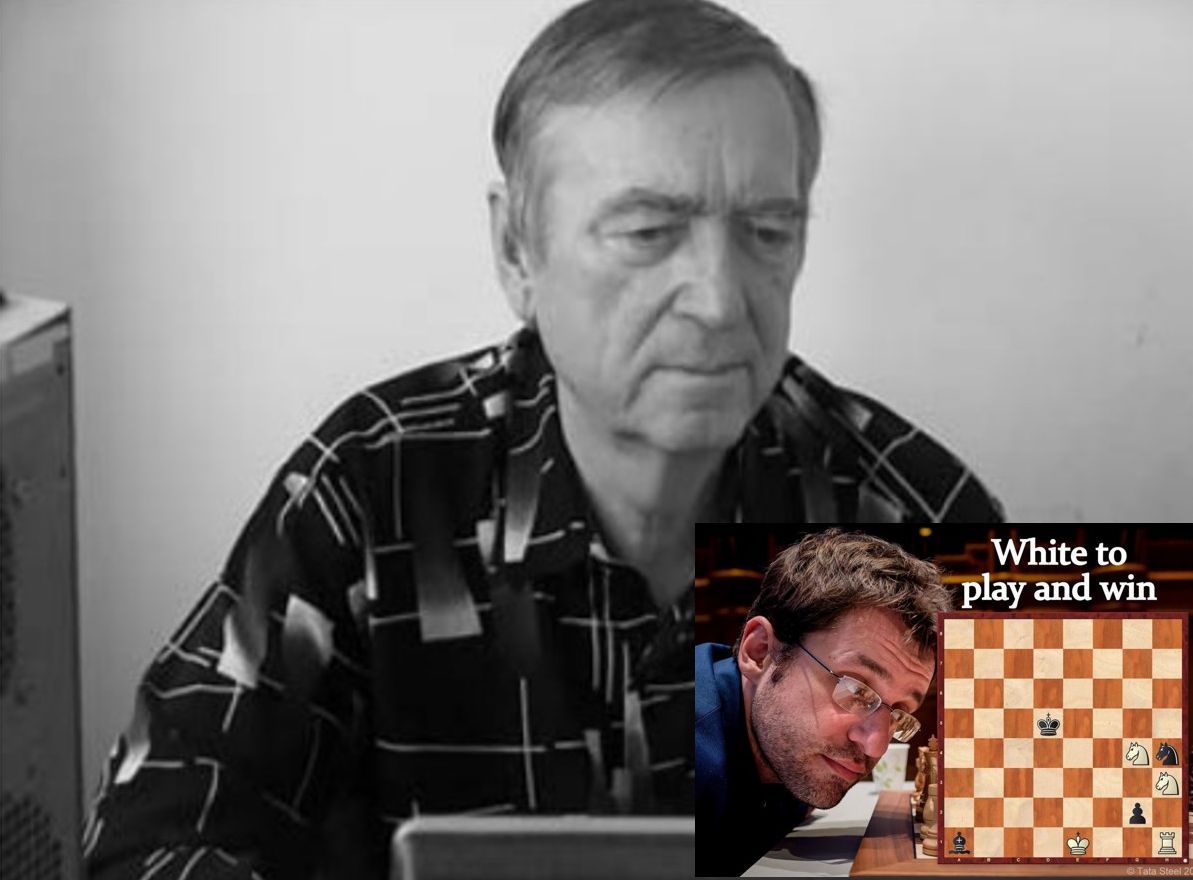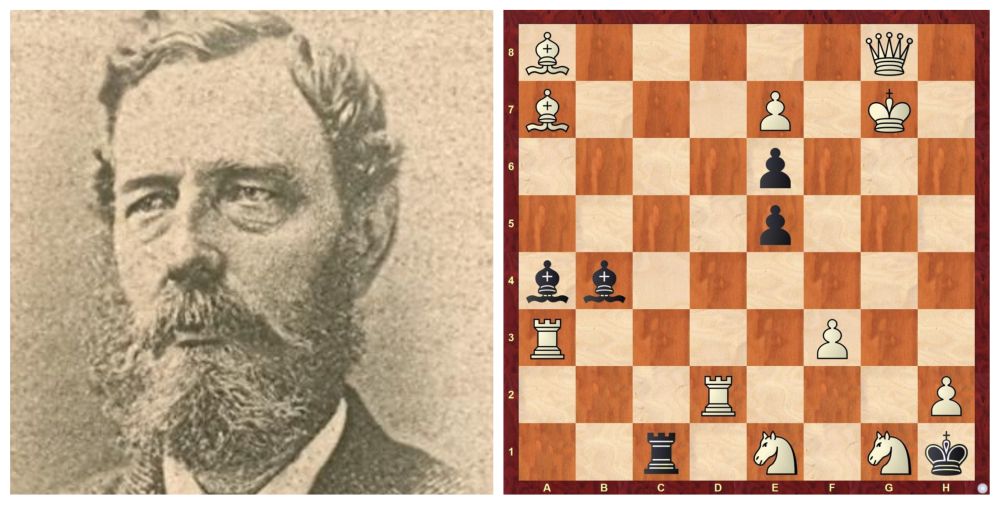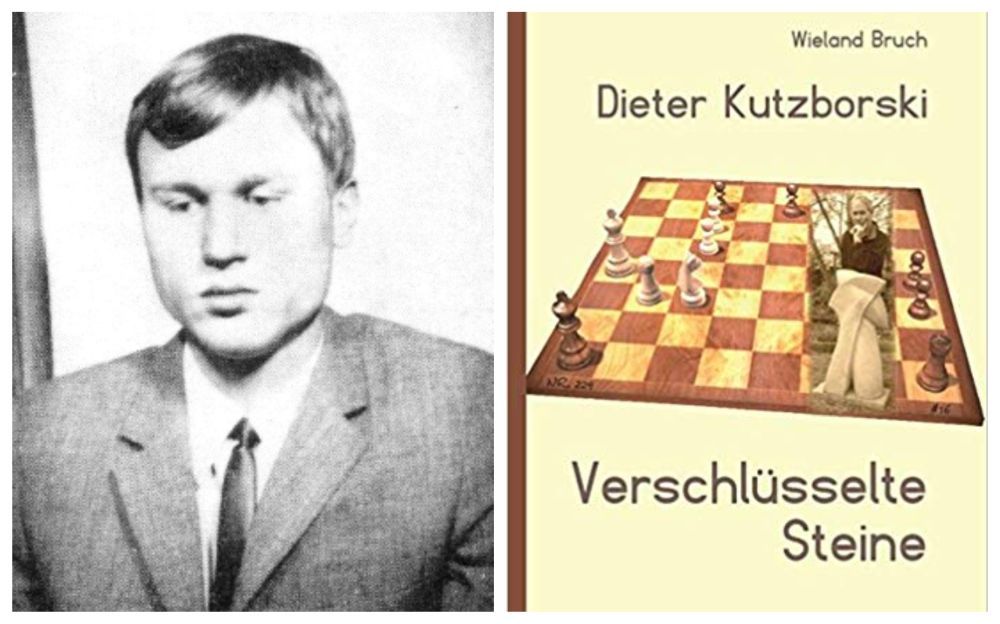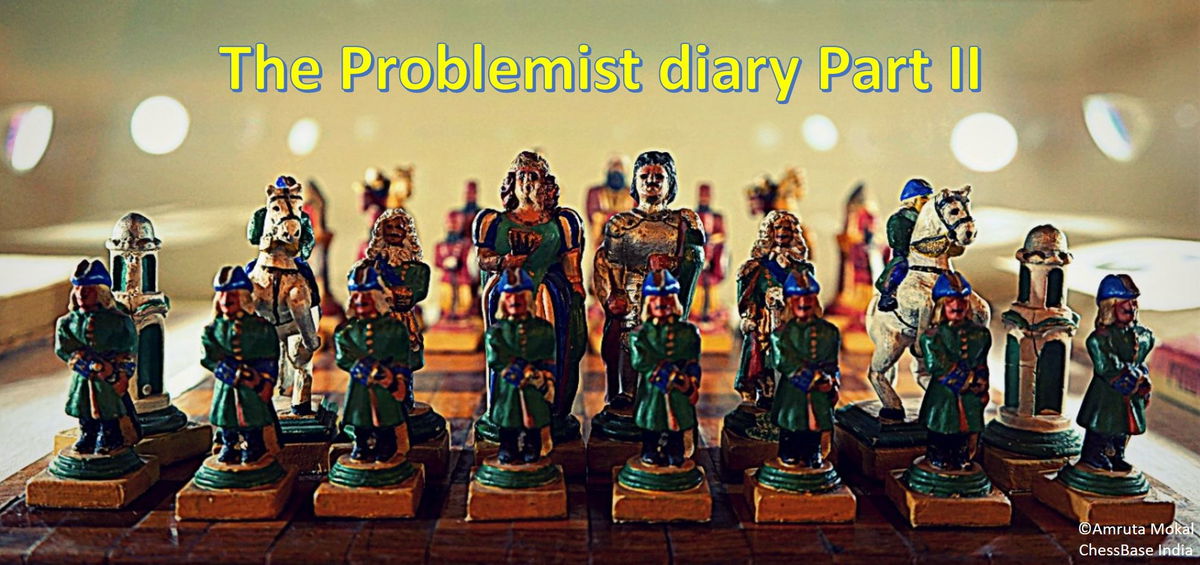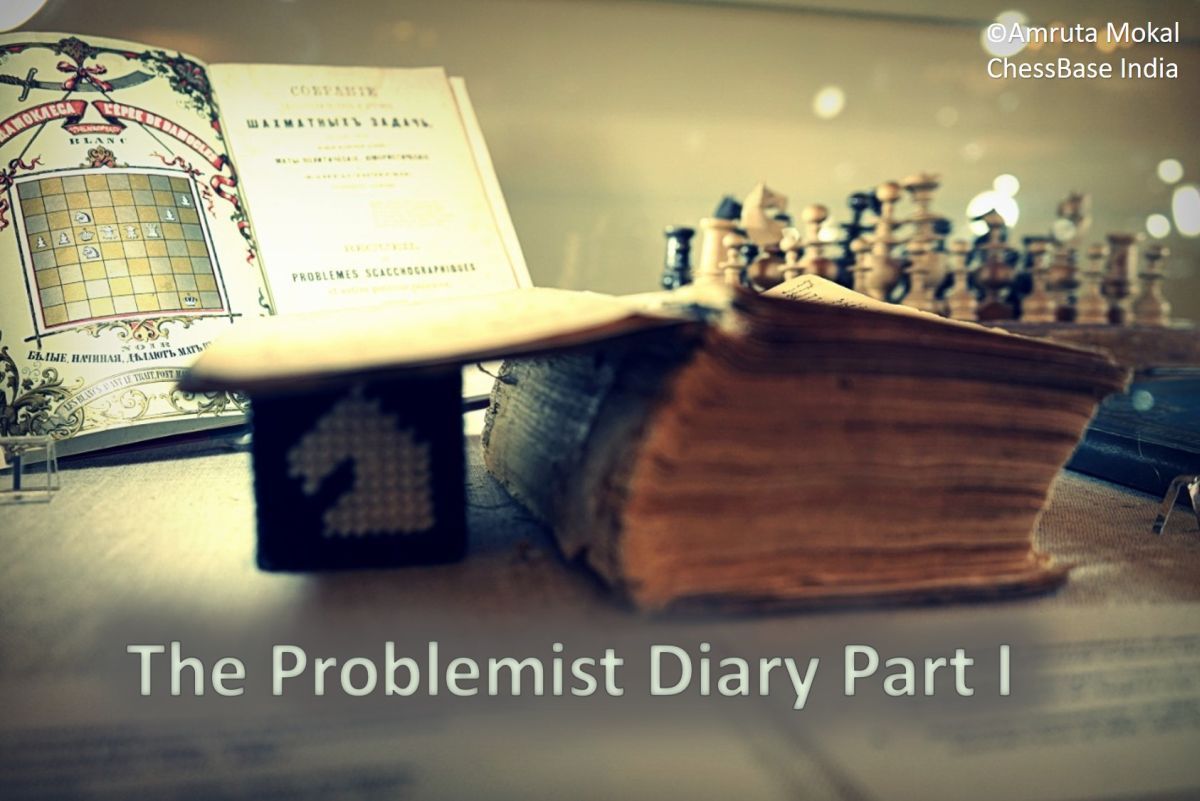Giants of Modern Studies Part I - The Tactical Thaumaturgy of Steffen S. Nielsen
Chess can be many things to many people. For most it is a hunt for perfection in over-the-board play, for some a scientific quest for abstract truths, but for even fewer it is an artform. Steffen Slumstrup Nielsen of Denmark is one of those rare personalities who in recent times has carved out a name for himself as a chess artist par excellence. He is among the brightest and most creative composers active in the world today. The Endgame Study is his field of expertise and in it he has already established himself, in a matter of only a few years, as one of the very best. In this exclusive feature article ChessBase India's author Satanick Mukhuty picks his mind, critiques his works, and tries to bring out a glimpse of his singular creative genius.
“Chess is everything: art, science, and sport.” ~ Anatoly Karpov
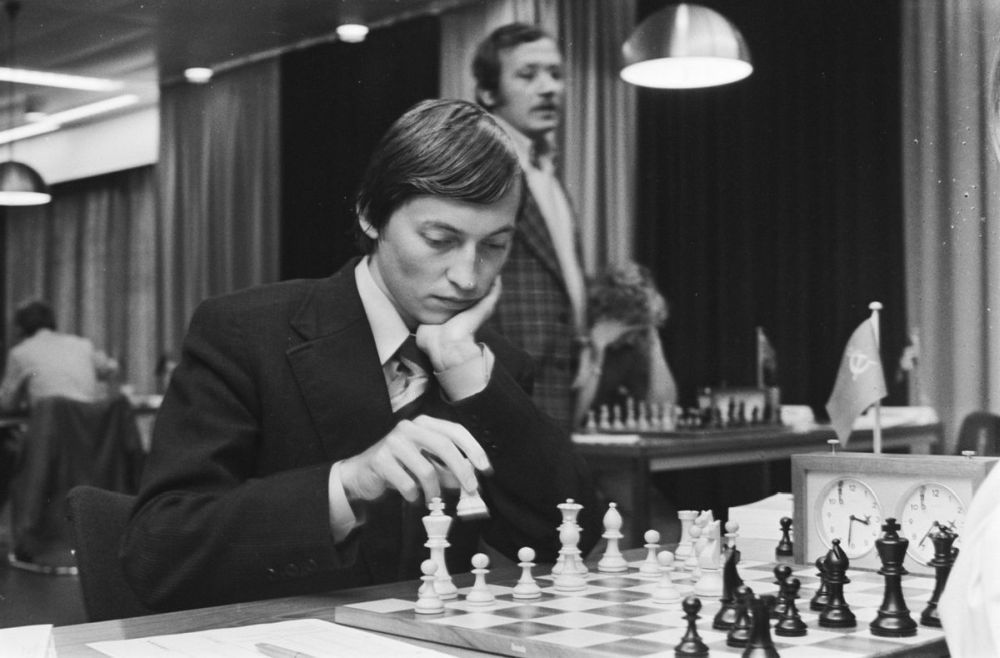
When we talk of all the great thinkers who have radically shaped the way we perceive and understand chess today, it is customary to quote names of legendary players such as Tal, Fischer, or Kasparov. These were indeed the men who, through their unparalleled talent, rigorous training, and on occasions, even sheer tenacity, pulled off such extraordinary feats of performance that chess elevated from being a mere intellectual frolic to assuming the stature of a legitimate sporting activity. Surely, these giants did a priceless service to our beloved game not just by pushing its theoretical and psychological boundaries forward, but also by putting it on the map of contemporary world sport, so to speak; giving it the standing and glamour that it rightfully deserves.
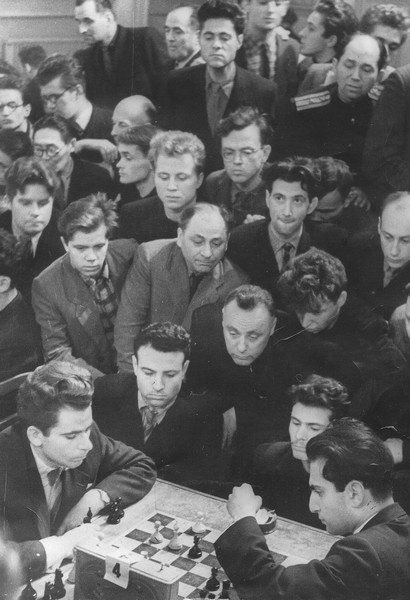
Yet those of us who love chess can't help but regard it as something more than just a contest of wits. As much as we cherish those online blitz winning streaks, chess also continues to fascinate us with its mysterious beauty, baffle us with its fathomless depth. In this sense, in its endless search for harmony and truth, it quite remains an art, a science. Therefore, it is only fitting that we also start counting our chess artists and our chess scientists in the list of the leading chess thinkers. From pure theoreticians and correspondence players to composers and problemists, there is no dearth of unsung talent in the world of chess, impeccable artistic and mathematical minds working tirelessly and, more often than not, in complete obscurity to stretch the limits of the game as we know of. For the culture of chess to flourish and reach its next level of acclaim it is imperative that we start fully recognizing their labours as well. The future of the game lies very much in the integration of all the various elements it represents - the artistic, the scientific, and the competitive. Thus, to thrive as a community, it is time that we bridge our inner differences and dichotomies, and seek a plenary unifying transformation.
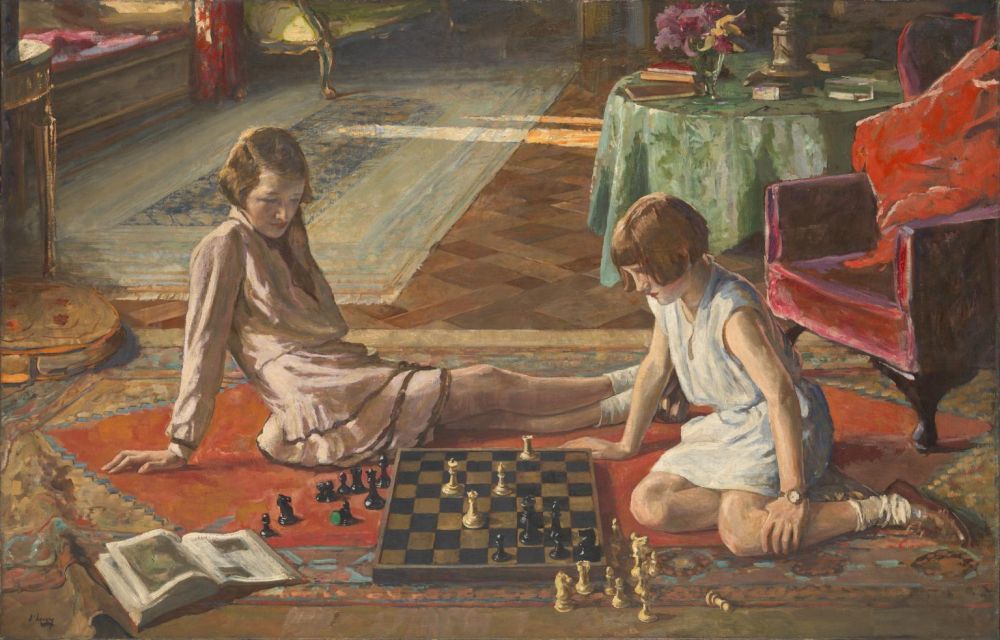

With this in mind, in the present article (the first part of what hopefully will turn into a considerably long series) we attempt to delve into the life and work of the prominent study composer Steffen Slumstrup Nielsen. If chess is an art then its composers are indeed its finest artists. A journalist by profession based in Denmark, Steffen Nielsen is undoubtedly one of the first-rate creative minds working out there at the moment. He became seriously interested in chess composition only less than a decade ago; considering the fact that a good many composers have careers spanning across three or four decades, he is still relatively new and yet, as many of his colleagues will readily attest, he has already climbed the topmost echelons of his field.


The Danish maestro has etched out a unique style for himself, a style that he himself describes as highly tactical or visual in nature drawing heavily on problem themes. This can be attributed in part to his diverse interests apart from composing endgame studies. He is far from a purist and regularly likes participating in over-the-board tournaments as well as solving competitions. Interestingly, he is keenly drawn to the genre of helpmate too. He actually quotes the following as one of his most loved problems of all time. This shows his distinctive taste, his penchant for the viscerally tactical; something that lends him an outlandish aura and makes him stand apart from his other esteemed peers.
Ofer Comay, 10th WCCT 2016, 1st Place
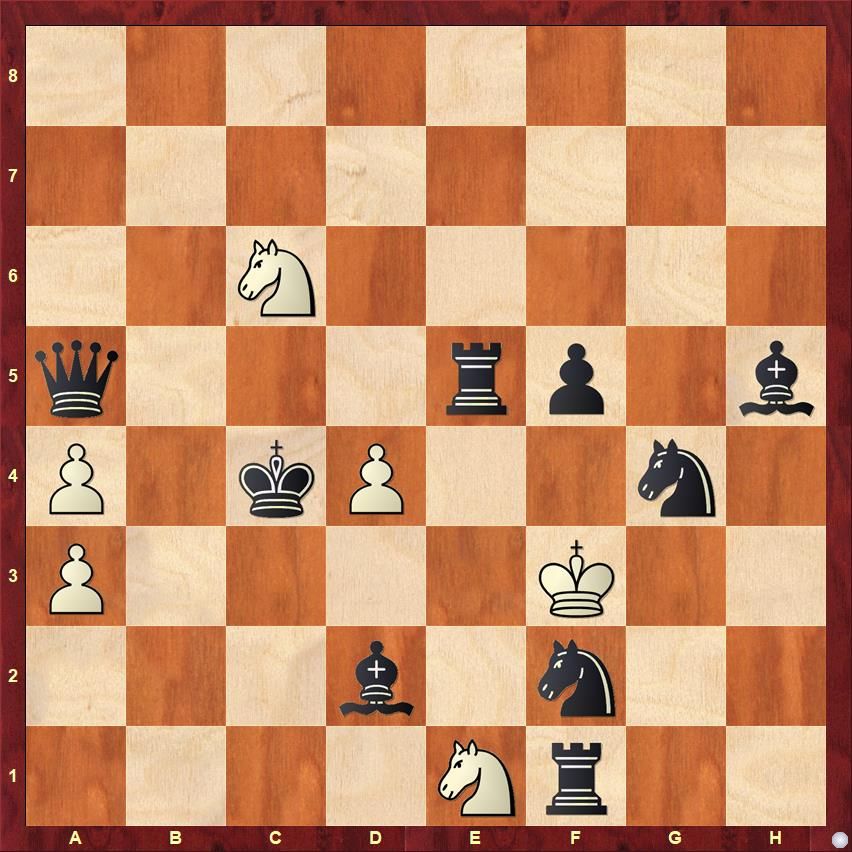
Recall that in a helpmate Black moves first and then both sides cooperate or in other words, help each other, to achieve the aim of checkmating the black king in the stipulated number of moves. The solution in this case involves a striking cross-check effect. 1.Ne3+ Kf4 2.Nd5+ Kxe5 3.Nc3+ Nxa5#. Black delivers consecutive checks in all three moves with one of its knights. White in turn takes this chance to transfer its king to a favourable square, and then meets the third and the final check by capturing the checking piece - the black queen - while simultaneously unleashing checkmate.
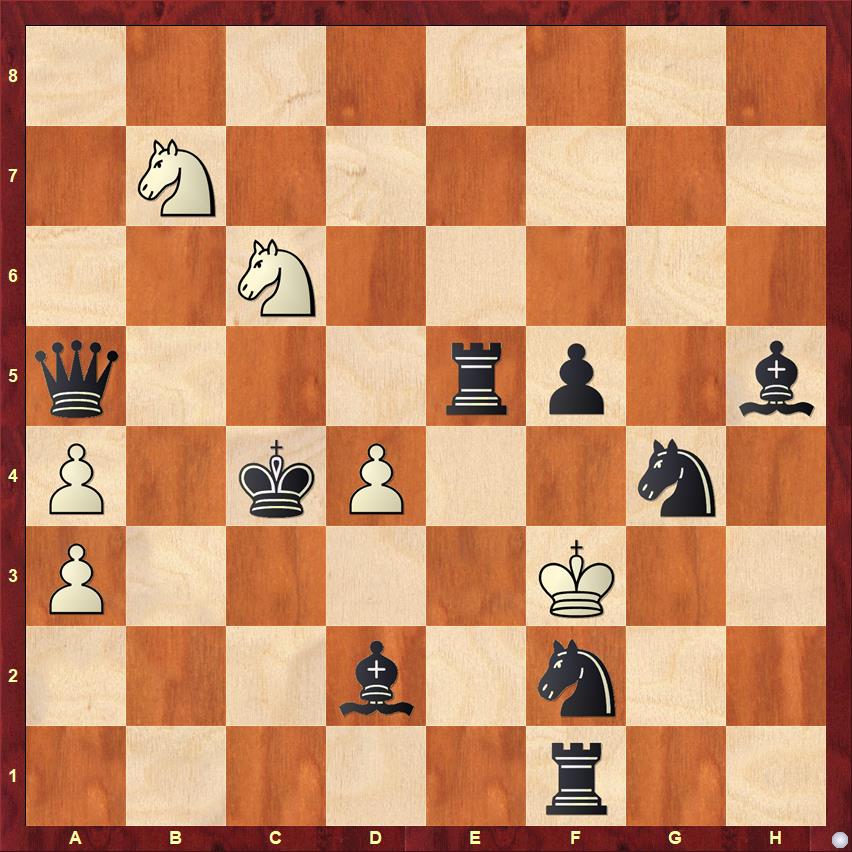
So in part (b) the white knight on e1 is shifted to b7, and we see how the solution is altered. 1.Ne4+ Ke2 2.Nc3+ Kxd2 3.Nd5+ Nxa5#. Black delivers the consecutive checks with its other knight now, and White too metes out the final checkmate with its knight on b7 instead of the one on c6. In both the solutions the black knights not only deliver consecutive checks but also crucially help close the lines of bBd2, bQa5, and bRd5 which facilitate White to move its king to the squares desired; e5 in the first phase and d2 in the second.
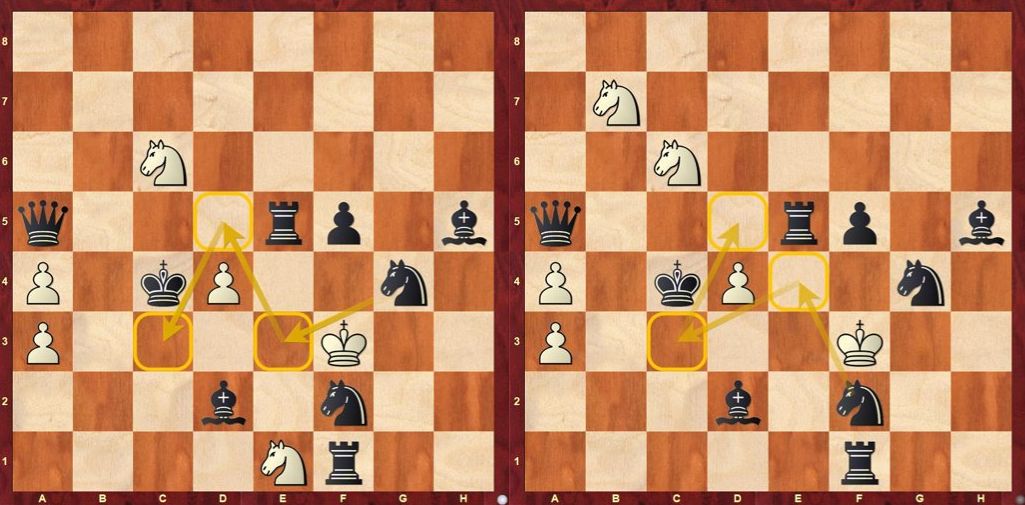
Complex visual effects like this one occur frequently in problems but less so in studies. Steffen however is motivated by them and his creations are therefore often distinguished by such problem-like tactical schemes. The following "short" study for instance, that won a special prize in the Mario Garcia 70 years Jubilee tourney, illustrates this well.
Steffen Nielsen, Garcia 70 JT 2018, Special Prize
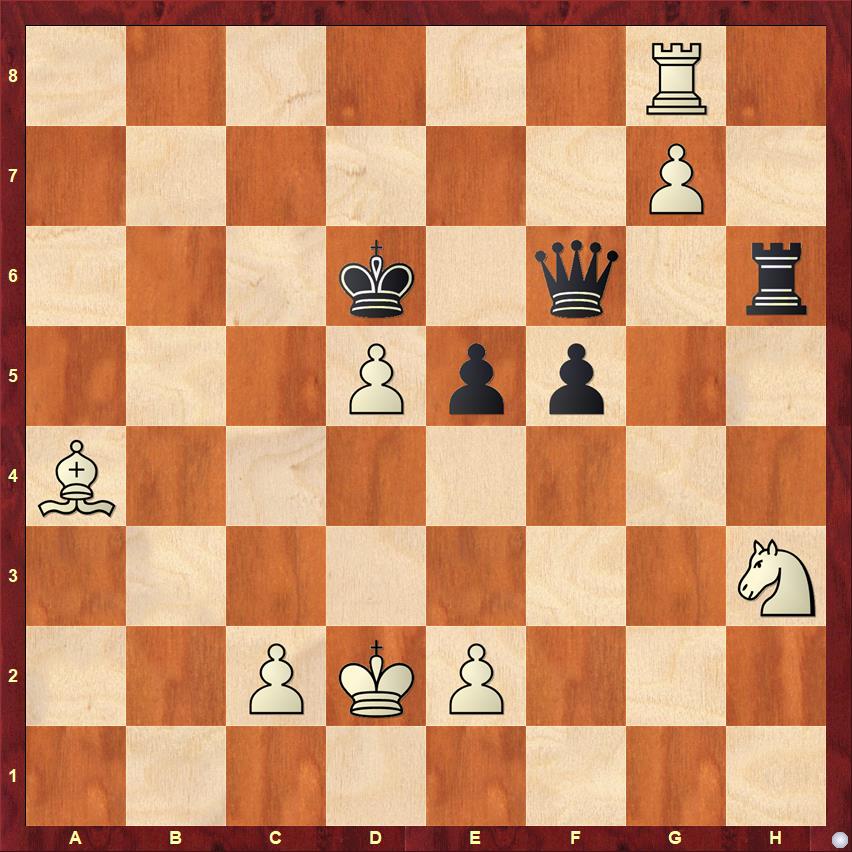
White must take swift action in the above position or else Black, who has a queen, will easily turn the tables. The solution begins with 1.Rc8! threatening both g8Q and Rc6+. Black goes with the only logical choice 1...Qxg7, but now White exploits the exposed king on d6. The play follows 2.Rc6+ Kxd5 3.c4+ Kd4 4.e3+ Ke4 and now as the black king on e4 finds itself in a tough spot, in comes a dazzling stunner!

The point here is, if Black captures that rook on g6 then Black's queen and rook end up interfering each other's paths and that actually allows White to deliver the coup de grâce. For example, 5...Qxg6 runs into 6.Bc6+ Qxc6 (as 6...Rxc6 isn't possible) 7.Ng5#; and if 5...Rxg6 then comes 6.Ng5+ Rxg5 (as 6...Qxg5 isn't an option) 7.Bc6#. This particular interference device is termed as the Plachutta. Once again an oft-seen idea in problems rather than studies.
Just like the way top chess players of the world are incredibly adept at finding resourceful moves over the chessboard, the top chess composers too are able to quickly spot ideas that might crystallize into their next original production. They find inspiration rather spontaneously and you would be greatly impressed how efficiently they are able to move from a concept to its actualization. Steffen is no exception in this regard. Take for instance the position below that occurred in a game between the Chinese superstar Ding Liren and the Russian phenom Daniil Dubov from the recently concluded Lindores Abbey Rapid Challenge.

Ding Liren - Daniil Dubov, Lindores Abbey Rapid Challenge 2020
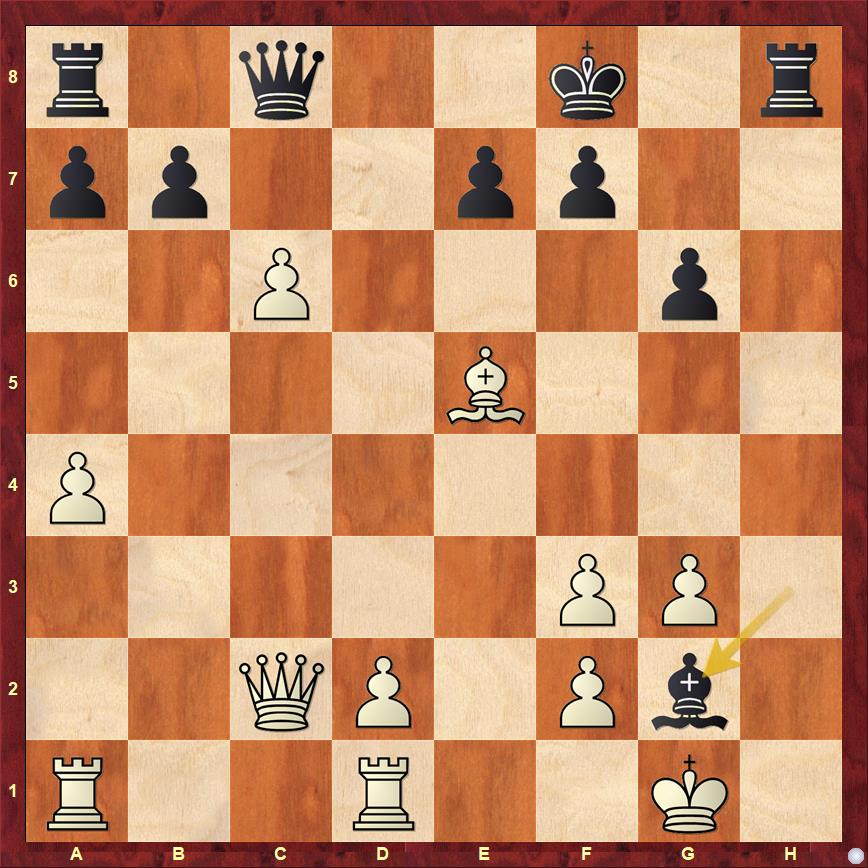
Dubov crushed Liren in just 21 moves in this game and the final blow that enforced the Chinese no.1's resignation was the above. Now for most of us this move 21...Bg2 will just feel like a routine tactic that incidentally appeared in an encounter between two extremely strong Grandmasters. Of course, White is hopeless here in view of the impending Rh1+ followed by Qh3. However, when Steffen saw this he perceived much more than just that. "The fun thing about this combination is that it only works against the pawn formation f2/f3/g3. Even the pawn on d2 is needed or White could simply play 22.g4 Bxf3 23.Bxh8 and run with the king. So even though it may seem standard it is in fact quite special," he explained in a Facebook conversation. No wonder these observations quickly led him to put together the following remarkably ingenious study.
Steffen Nielsen, Dedicated to Daniil Dubov, 2020
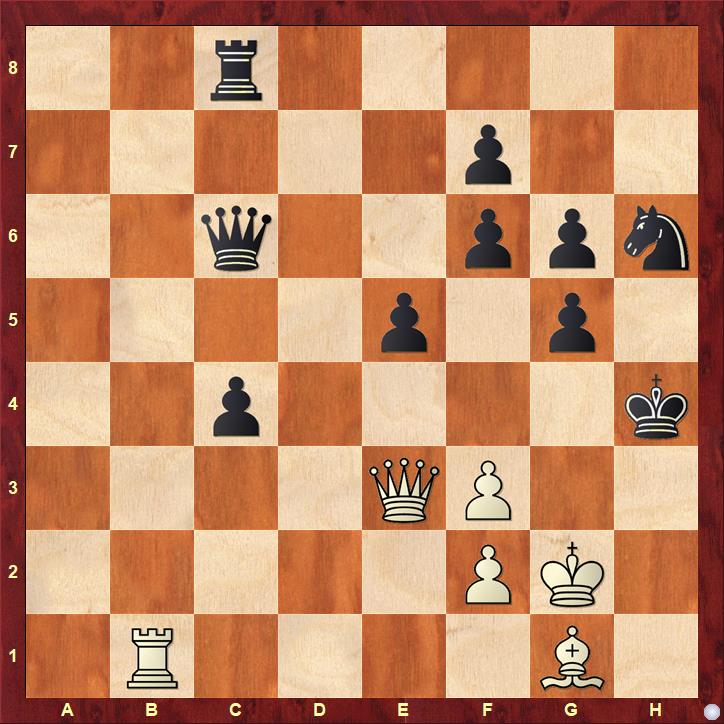
Black is profusely ahead in material so White must act immediately to create threats against the exposed black king. 1.Bh2! simply threatens Bg3+ followed by Rh1#, 1...Nf5 2.Bg3+ Kh5 3.Rh1+ Nh4+ 4.Bxh4 and now 4...gxh4 is not possible because of 5. Rxh4+ Kxh4 6.Qh6#, so Black continues with 4...Kh6 and after 5.Bxg5+ Kg7 6.Bh6+ Kg8 the main idea from the game is realized, White plays 7.Bg7!!
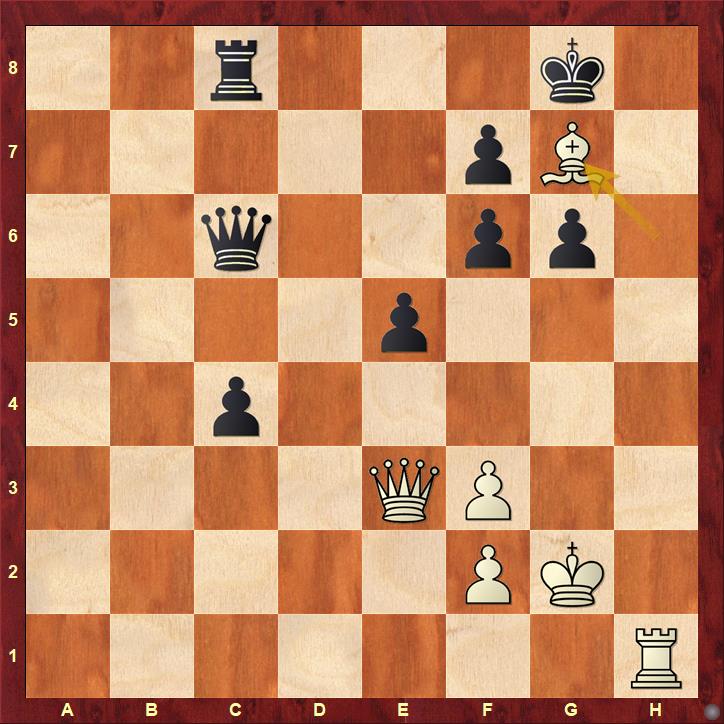
Just like in the game (but only colours reversed!) Rh8+ followed by Qh6+ is threatened here, and 7...Kxg7 is obviously not feasible with Qh6+ coming. Hence 7...g5, Black makes one last attempt to thwart White's onslaught but now comes 8.Bh8! and Black is completely lost as there's no good way to prevent Rh6 and the threat of Bxf6 that follows thereafter! Well, Black might try something like 8...Rd8 9.Rh6 Rd6 but White crashes in anyway with 10.Qa7 Kf8 11.Qb8+ Ke7 12.Bg7 etc - a devastating attack!
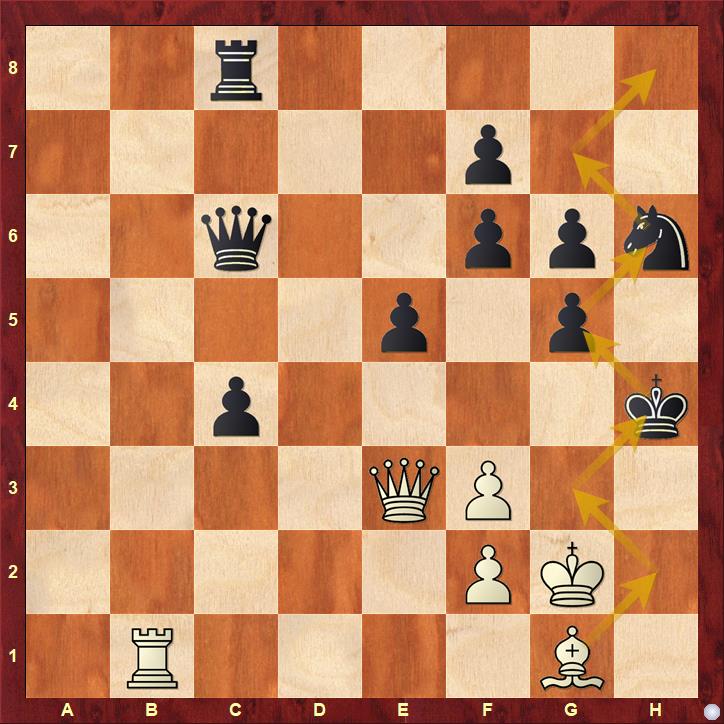
Steffen actually debuted his first study in 2012 and got his big break later in the same year when he won the Timman-60 Jubilee Tourney. There was no looking back after this, he quickly went from strength to strength and in no time catapulted into the elite circle of study composition. The fact that he secured eighth place in the World Championship in Composing for Individuals (WCCI) 2013-15, which in fact was his very first participation in the event, is a testament to his phenomenal talent.
Steffen Nielsen, Timman JT 60 2012, 1st Prize
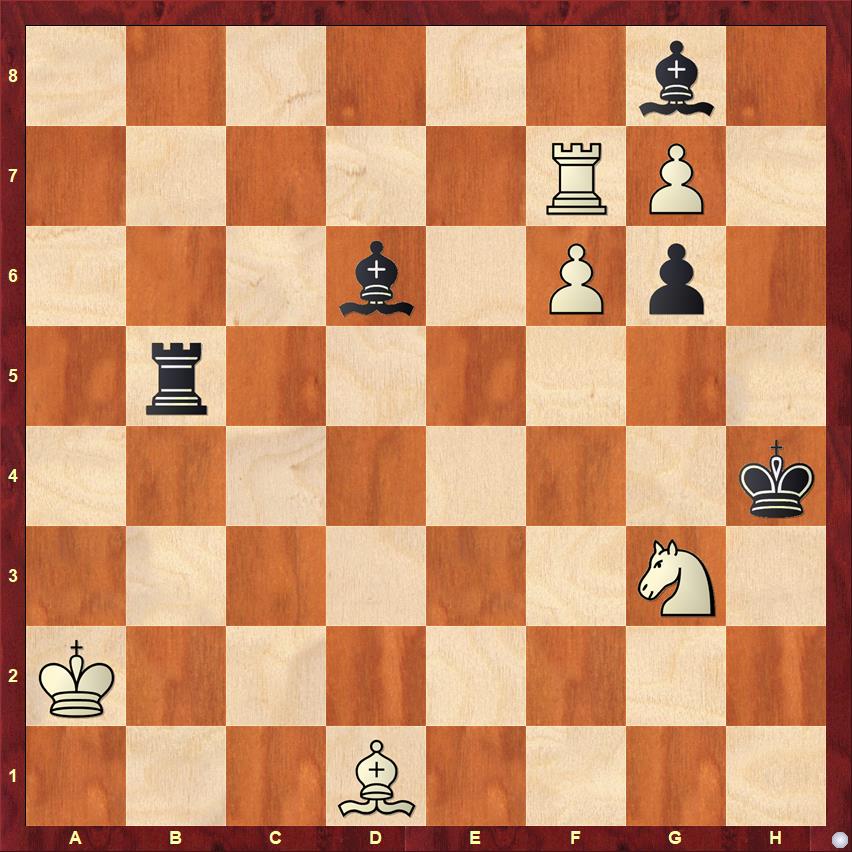
The above is the magnificent production that won him the first prize in the Jan Timman 60 years Jubilee Tourney ahead of such towering figures as Yochanan Afek, Sergiy Didukh, and Oleg Pervakov. White's position seems completely hopeless here, the white rook on f7 is pinned and is beyond saving. But can the white pawns on f6 and g7 pull off a miracle? 1.Bb3 Rxb3 and now 1...Kxb3? 2.Bxf7+ is utterly lost, but White instead surprises with a cascade of sacrifices: 2.Rf8! Bxf8 3.Nf5+! gxf5, and finally comes 4.f7!
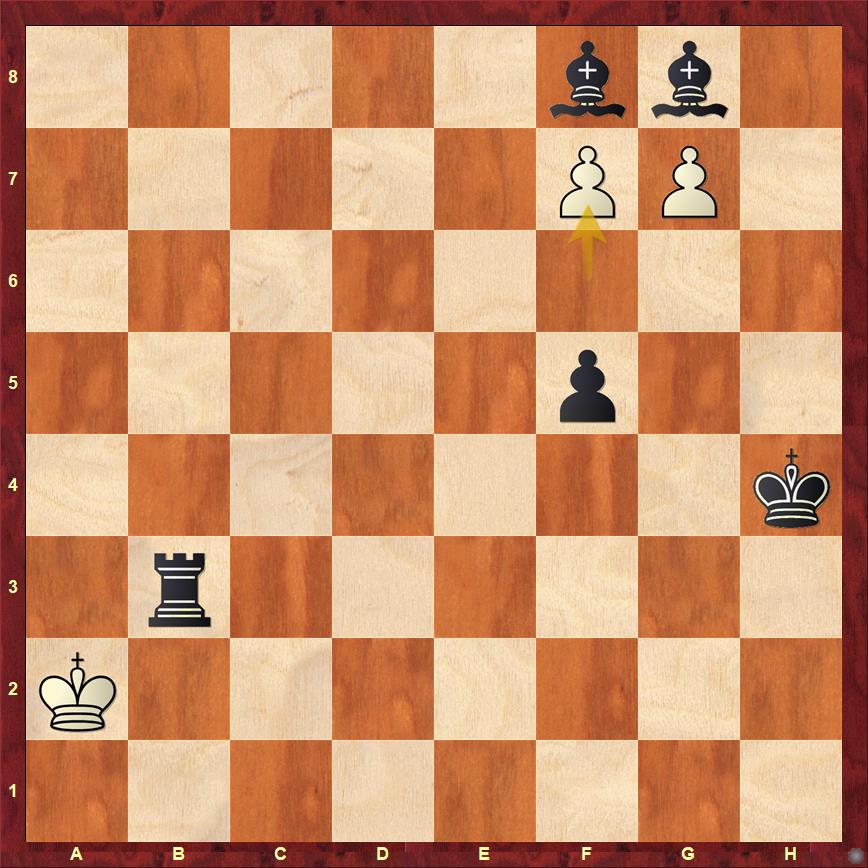
But still, is this enough to hold? Well, it turns out that White will still have to walk a precariously narrow path constituting a series of only moves. A slip here or a slip there is enough to completely hand over Black the victory. For instance, after 4...Rb2+ 5. Ka1 Ra2+ 6.Kb1 Ra1+ 7.Kc2 Rc1+ of the mainline, a slight carelessness like 8.Kd2 lets all hell break loose as Black immediately gets in 8...Bb4+ and quickly winds things up thereafter. Similarly, 8.Kb2 and 8.Kb3 too run into 8...Bxg7+ and 8...Bxf7+ respectively. So 8.Kd3! is how White continues, and again after 8...Rc3+ 9.Ke2 Rc2+, it turns out that 10.Kf1! is the only move that keeps things together (see annotation below). Thus, in this manner, Black is ultimately forced to yield to a repetition. You can checkout all the nuances by playing through the full analysis in the replayable board below.
Going through these studies you must be wondering: how is it that a 45-year-old adult who has a family and a full-time job to work at find so much time to design positions of such exquisite complexity? Well, all great artists find a way to create no matter what. "You either get it down on paper, or jump off a bridge," the ever-voguish iconoclastic American poet and writer Charles Bukowski had once deftly remarked about the process of writing. The same is true for chess composing - you either do it or you don't. A passionate composer doesn't fold his hands on the pretext that he doesn't have the right conditions around him. Steffen manages to steal time from in between routine activities. He tinkers away with chess pieces when he is on a commute or between breaks at work. He is sporadic but incessant, unstructured but passionate. And that is how, patiently and doggedly over the years, he has managed to create specimens which can aptly be called masterpieces! His best is certainly yet to come but his oeuvre has already grown significantly rich. We present to you next a small collection of his choicest creations, creations that have truly broken new grounds in the field of modern studies.
Study 1
Olympia Dunyasi 2015, Special Prize
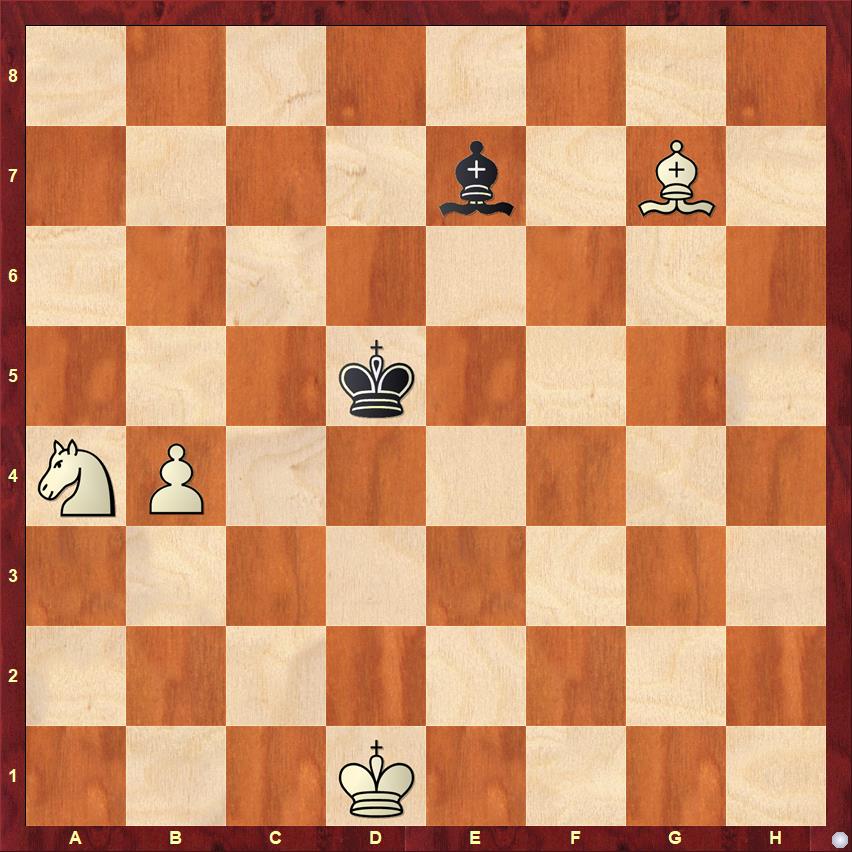
We begin with a light miniature that should especially be instructive to tournaments players. 1. Nc3+? Kc4 2. b5 Bc5 and 1. Nb6+? Kc6 clearly don't work, so White begins most naturally by pushing the b-pawn. 1.b5 Bd8 and now 2.Bf8! - a subtle move meant to keep the black king at bay. 2.b6? is an inaccuracy as after 2...Kc6 3.Bd4 Kb5 4.b7 Bc7 5.Nc5 Kc6 6.Kc2 Bd6 7.Kb3 Kc7 8.Kc4 Bxc5 Black holds fort. 2...Kc4 3.b6 Kb5 4.b7 Bc7 5.Nc5 Kb6 follows next, and now comes the pivotal move of the study: 6.Ke2!!
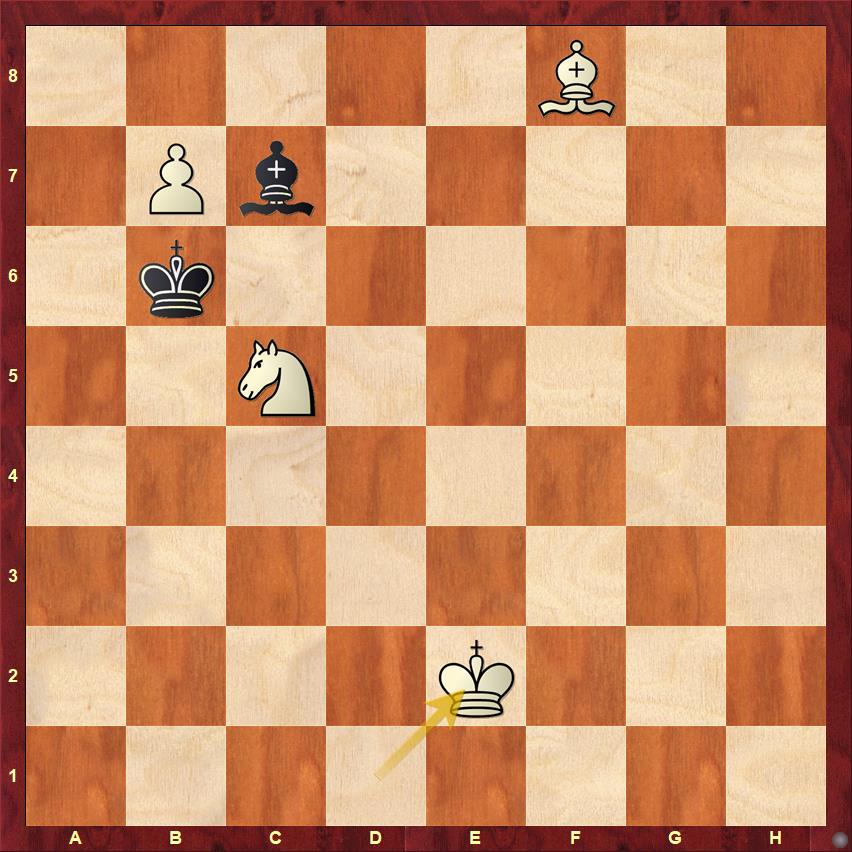
This move looks quite innocuous at first glance but later proves critical. Why do you think 6.Kd2 or 6.Kc2 don't work? Well, try 6.Kc2? Ka7 7.Kd3 Bb6 8.Bd6 Bc7! 9.Bxc7 and Black forces stalemate. But after the reti-esque 6.Ke2!! we have 6...Ka7 7.Kf3! Bb6 8.Bd6 Bc7 9.Bf4/g3 and ultimately the subtle point behind is revealed. Ke2 is actually the key move needed to keep control of the important f3 square, in order to be able to later meet 8...Bc7 with either 9.Bf4 or 9.Bg3!
There can also be an alternative continuation with 6...Bb8. In this case White simply brings the king into the thick of action and manages to promote the b-pawn: 7.Kd3 Ba7 8.Kc4 Kc7 9.Kb5 Bxc5 10.Ka6 Bxf8 White just wants to support the b-pawn, nothing else matter, 11.Ka7 Bc5+ 12.Ka8 and wins. An elegantly slender and dynamic production!
Study 2
Schach 2018, 1st Prize
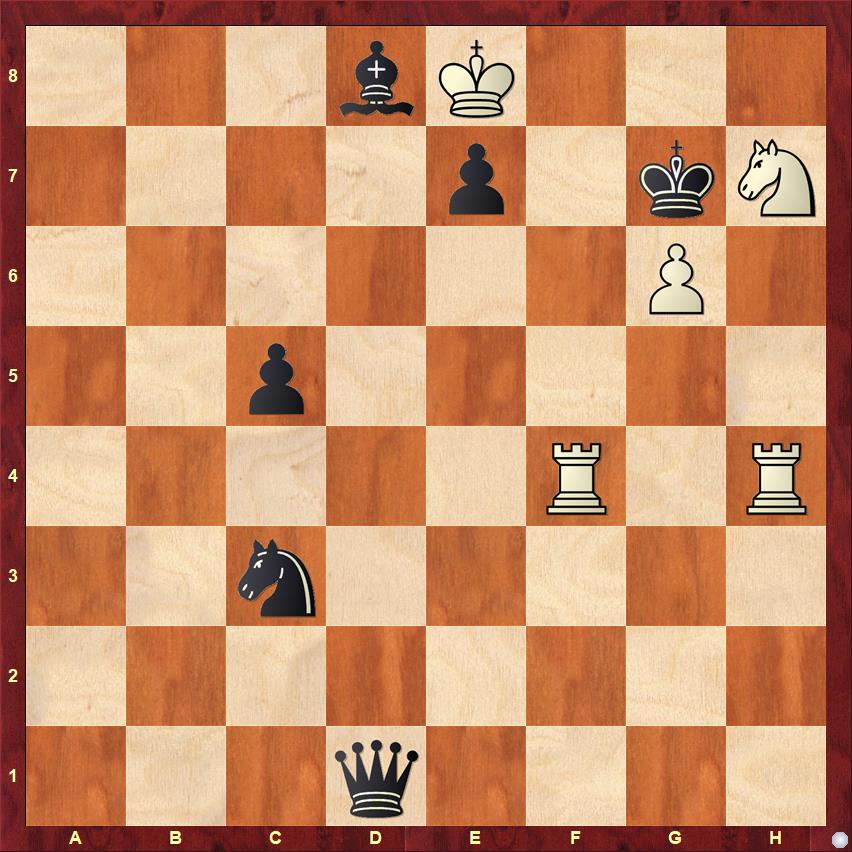
Perhaps with this study we really enter into what can be called the hardcore Nielsen territory. White begins with 1.Nf8, as 1.Rf7+ Kxg6 2.Nf8+ etc clearly don't go anywhere, the g6 pawn is actually preserved in order to create threats later. Black must take guard now as all sorts of threats with Rh7+ and Rf7+ are in the air. 1.Nb5, for instance, is careless and allows White to overwhelm with 2.Rh7+ Kg8 3.Rh8+ Kxh8 4.Ne6, a deadly double-attack. 1.Qd6, on the other hand, is met with a surprisingly long forcing line: 2.Rf7+ Kg8 3.g7 (threatening 4.Rh8#) 3...Qc6+ 4.Nd7 Qxd7+ 5.Kxd7 Kxf7 6.Rg4 Kg8 7.Kxd8 e5, and here Black has nothing better to do than just push the e-pawn. It isn't fast enough though and White wins without much trouble after 8.Ke7 e4 9.Kf6 e3 10.Kg6 e2 11.Rf4 for there isn't any way to parry the mate threatened in the next move. The mainline therefore continues with 1...Nd5 and 2.Rh7+ Kg8 3.Rh8+! Kxh8 4.Kf7 (threatening 5.g7#) 4...Qh5 5.Rh4 Nf6 follows next leading to the most critical moment in the study.
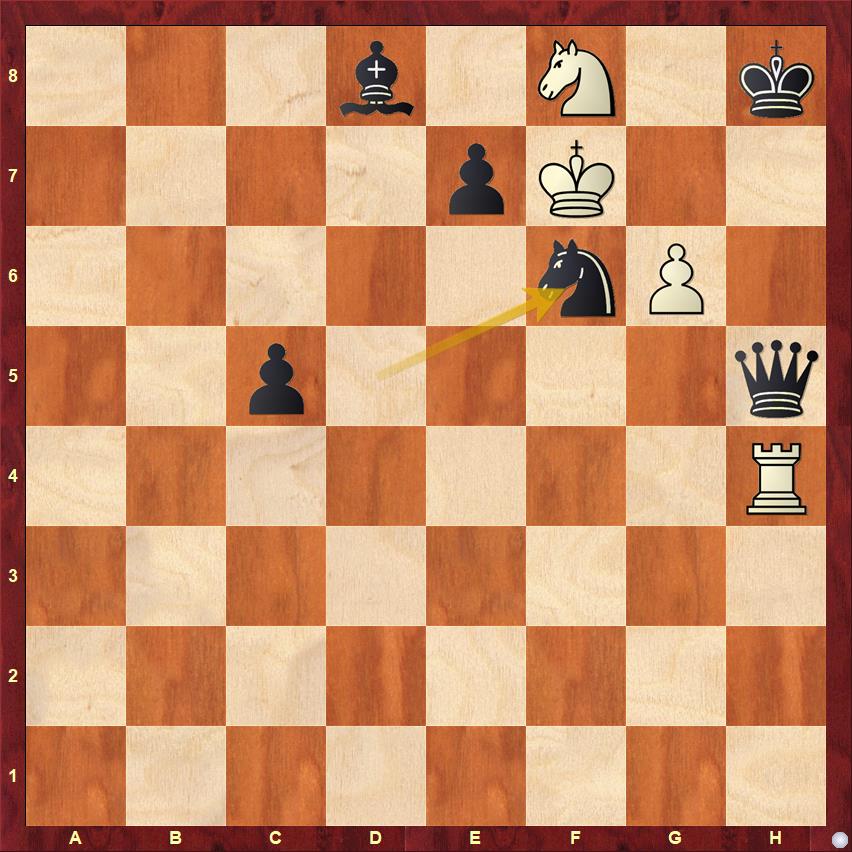
Well, ideally White would like to get in Nf8-d7 but 6.Nd7 straight away is premature because of 6...Qxh4 7.g7+ Kh7 8.Nxf6 Qxf6+, so clearly the rook on h4 must be transferred to a better square first. The correct move is 6.Rh1!! and only now 7.Nd7 Qxh1 8.g7+ Kh7 9.Nxf6+ Kh6 10.g8=Q followed by checkmate is a real threat. The other plausible alternatives fail to work due to some subtle reason or the other. Try 6.Rh3? Bc7 7.Nd7 Qxh3 8.g7+ Kh7 9.Nxf6+ Kh6 10.g8=Q Qb3+ equalizes. Try 6.Rh2? Bc7 7.Rh1 Bf4 8.Nd7 Bh6 is even winning for Black.
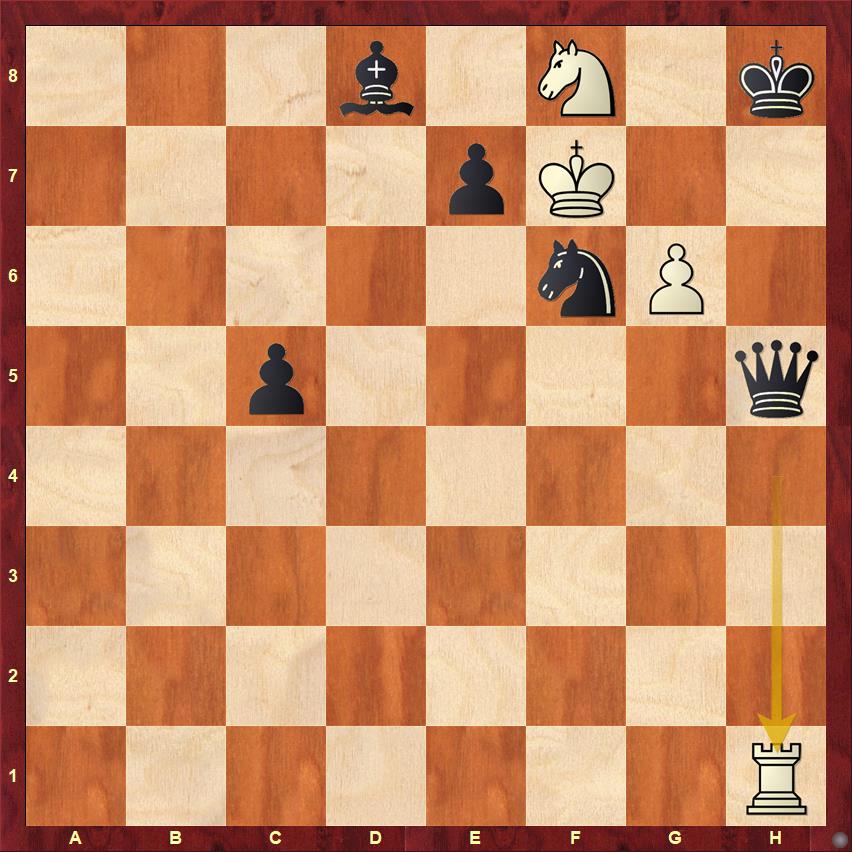
A good composition always equips the defending side with attractive hidden resources and this particular study achieves that quite gloriously. Black plays the move 6...e6!! here - defending subtly against the threat by opening up the seventh rank. Now 7.Nd7 would be met with 7...Qxh1 8.g7+ Kh7 9.Nxf6+ Kh6 10.g8=Q Qb7+. But take note that 6...e6 has also incurred a crucial shortcoming: the b3-f7 diagonal is closed now. Thus, White plays 7.Rh3, once again improving the position of the rook, exploiting the fact that Black doesn't have Qb3+ anymore!
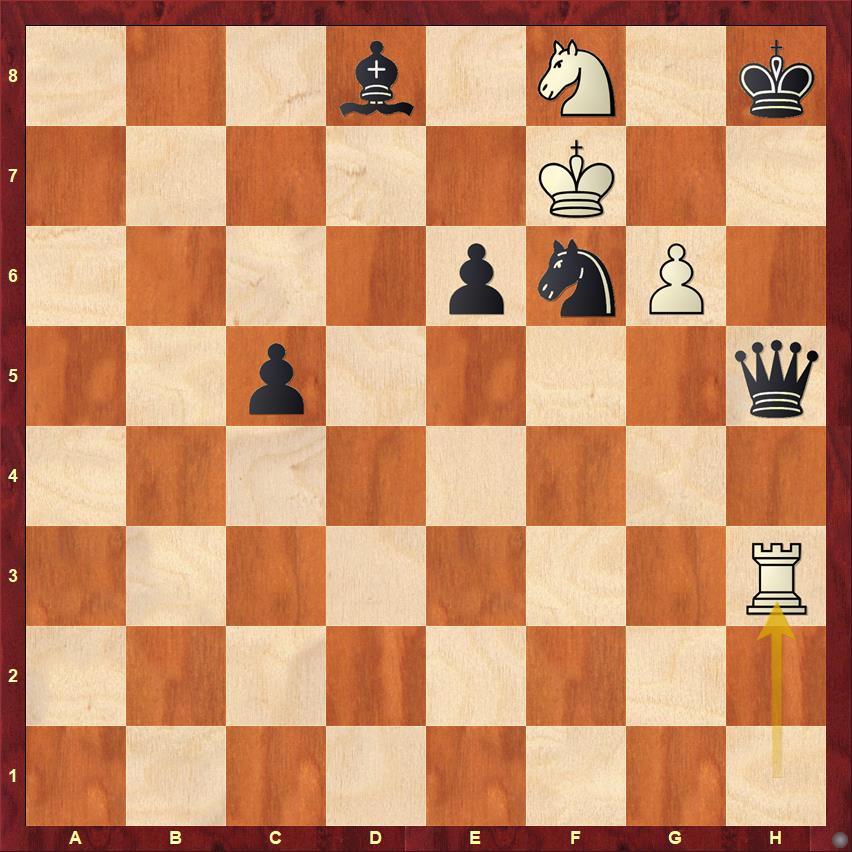
Black continues with 7...e5! again, cleverly opening up the b3-f7 diagonal. But now since the h2-c7 diagonal is closed and with that the threat of Qc7+ eliminated, White repositions his rook yet again for the third time with 8.Rh2! How magnificent! This maneuvering continues a little more with 8...e4 9.Nd7 Bc7 and 10.Rh1!

In a desperate bid, Black tosses out 10...Qxh1 but now after 11.g7+ Kh7 12.Nxf6+ Kh6 13.g8=Q White wins, as it is impossible to avert checkmate on both g6 and g7. A truly gorgeous jewel, the beauty of which will perhaps not fade in an eternity!
Study 3
Lev Lepkyi 130 (2018), 1st Prize
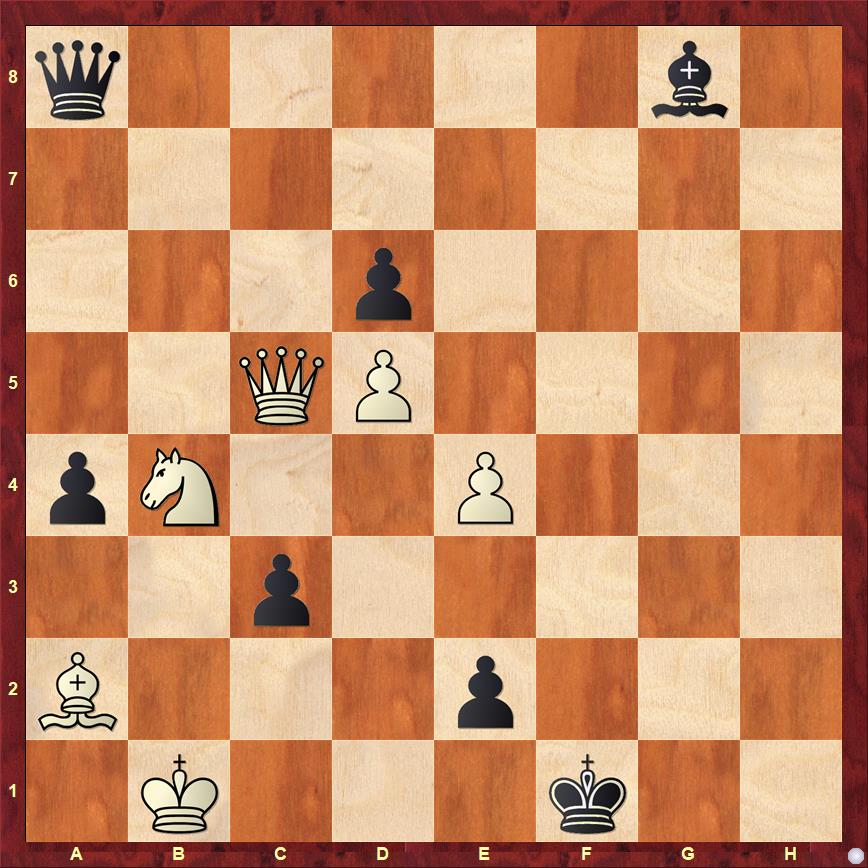
White is on the defensive in the above position, his biggest worry being the pawn on e2. However it is not yet time for active counterplay. 1.Qc4 loses to both 1...Bh7 and 1...Qe8. The square c4 is actually needed for the bishop on a2. Solution: 1.Qb5! Qe8 2.Qd3 White is not allowed to play Bc4 and is forced to retreat instead, 2.Qxe8? runs into 2...e1=Q+ 3.Kc2 Qd2+. 2...Qxe4 3.Qxe4 Bh7 Black pursues the white queen relentlessly. 4.Qd3! White too must endure and not lose focus of the e2 pawn, 4.Qxh7? e1=Q+ 5.Kc2 Qd2+ and we know what happens. 4...Kf2 Black unpins the pawn, 5.Qc2! and White retreats some more not letting go of the pin. But Black simply plays 5...Ke3 preparing e1=Q, and what does White do now?
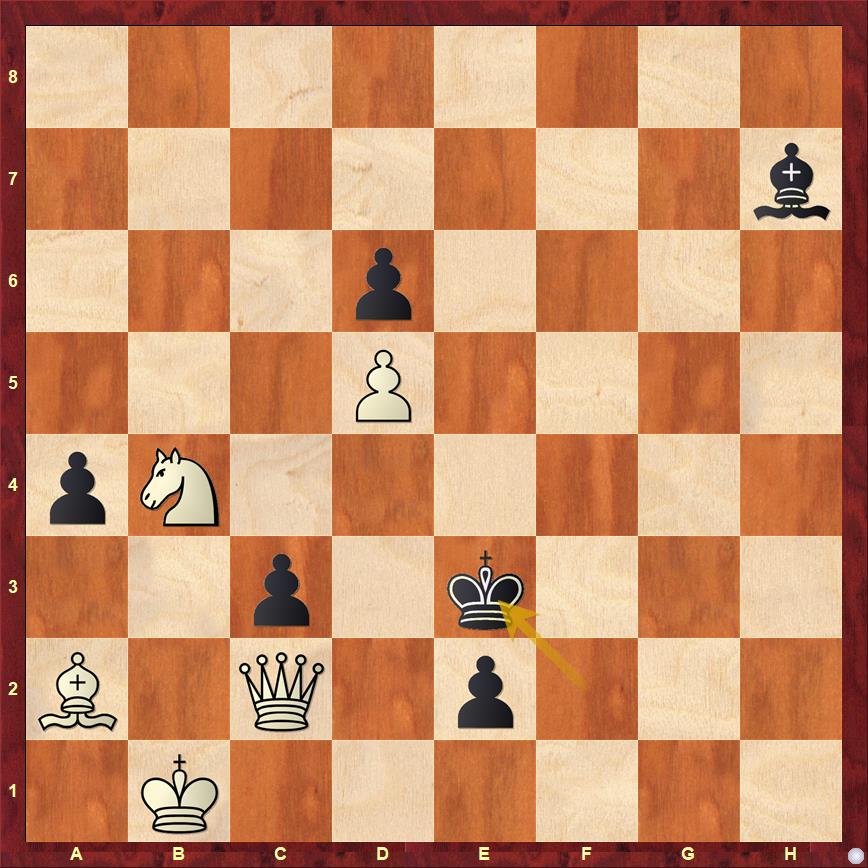
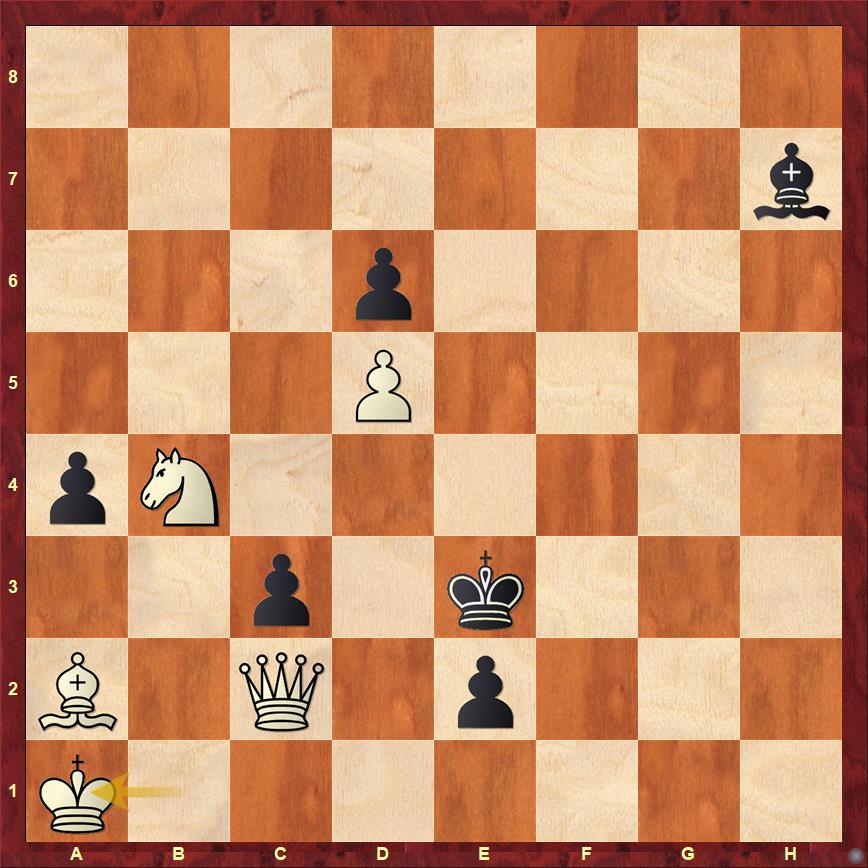
Next, White's pieces get driven all the more into the corner. 6...e1=Q+ 7.Bb1 Qd2! (7...Bxc2 not possible because of 8.Nxc2+ fork) 8.Qa2 Qc1 and finally 9.Nc2+! a check! White gives a check burying Bb1 and Qa2 even deeper! Who would have ever guessed that the path to redemption could actually lie through such hopeless passivity? 9...Kd2! 10.Nd4+ and now, at last, White strikes: 10...c2 11.Nb3+ axb3 12.Qa5+ Kd1 13.Qe1+ Kxe1, the stalemate combination hits almost like a bolt from the blue and suddenly, as the dust settles, we have a draw! This is escape by the skin of the teeth, literally so! Even the most pompous attacker can't help but envy this sort of outrageous defensive play. Brilliant!
Study 4
Chessstar 2018, 1st Prize
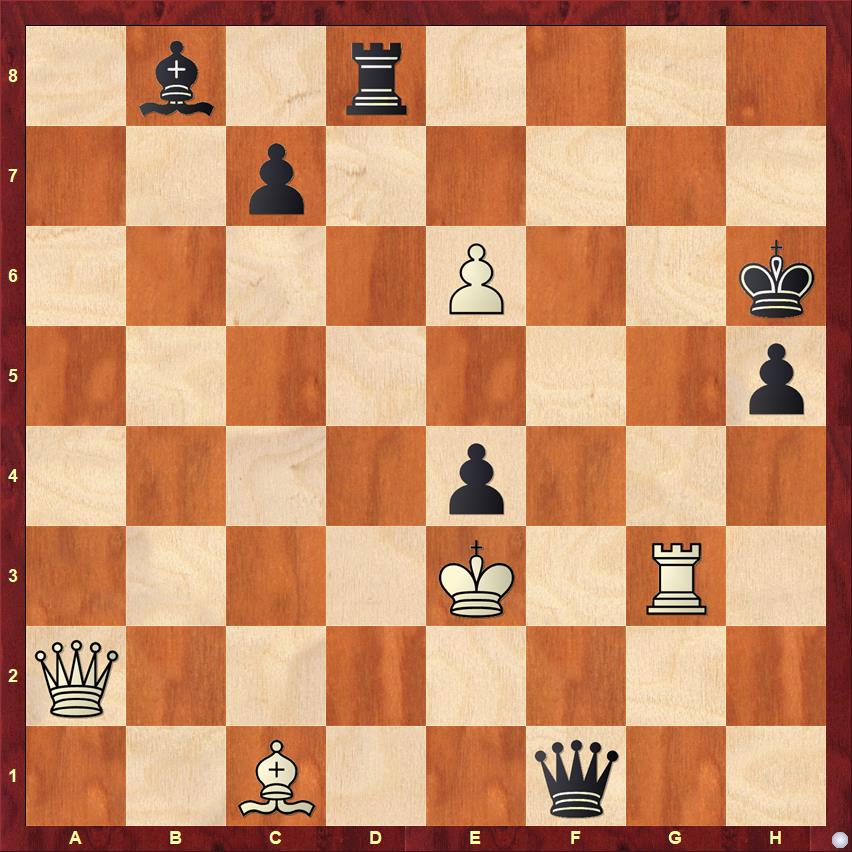
This study is perhaps Steffen's most outstanding creation till date. In fact it was one of the determining entries for the WCCI 2016-18 that helped him bag the bronze medal, and oh boy! so stupefyingly complex it is... The difficulty starts from move one itself. White intends to support the bishop on c1 and hit at the black king at once. There are several candidate moves that seem fit to serve that purpose: 1.Qa1, 1.Qb2, 1.Qc2, and 1.Qa3. But it turns out that of this four options it is only 1.Qa1! that works. This can be proved only through painstaking analysis which has been duly covered in the replayable annotation below. So let us in this text focus more on the mainline and try to appreciate the many twists and turns that abound it. 1.Qa1! obviously threatens Qg7# so now Black goes 1...Qe1+ 2.Kf4 Rf8+, and here after 3.Ke5+ e3 4.Bxe3+ we already arrive at a strange juncture.
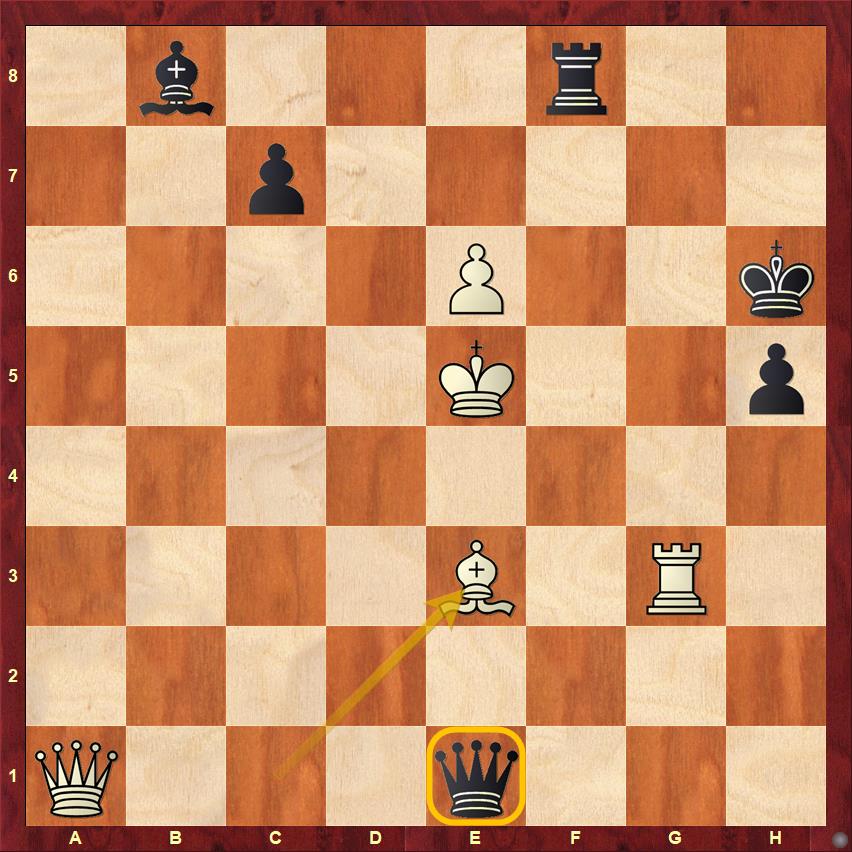
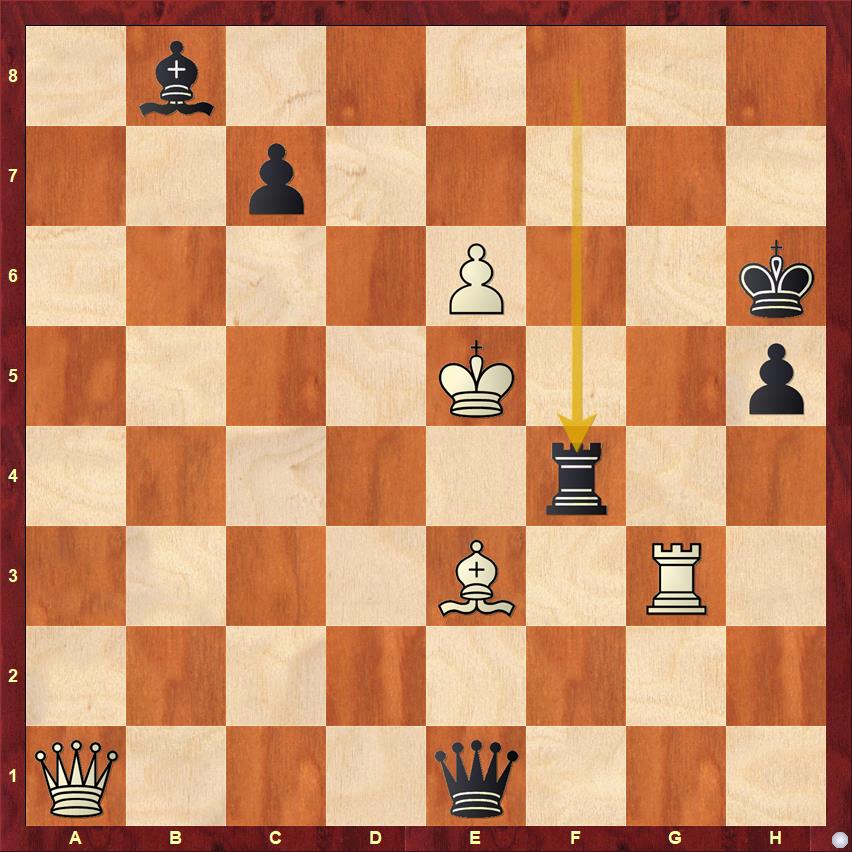
White can't capture 5.Qxe1 because (behold!) there comes the sneaky 5...c6#; nor can White pick up the rook because 5.Kxf4 runs into 5...Qxa1 6.e7 Qa4+ where there's no time for 7.Rg8. Thus, White contents with playing 5.Qb2 and the mainline continues 5...Qc3+ 6.Kxf4 Qxb2 7.e7
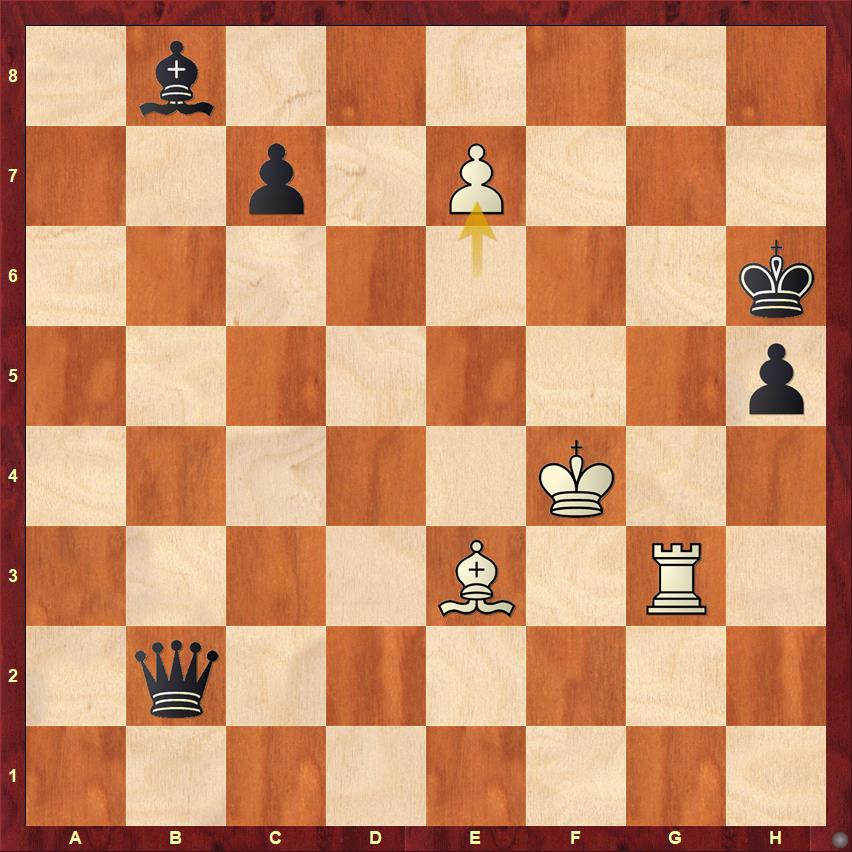
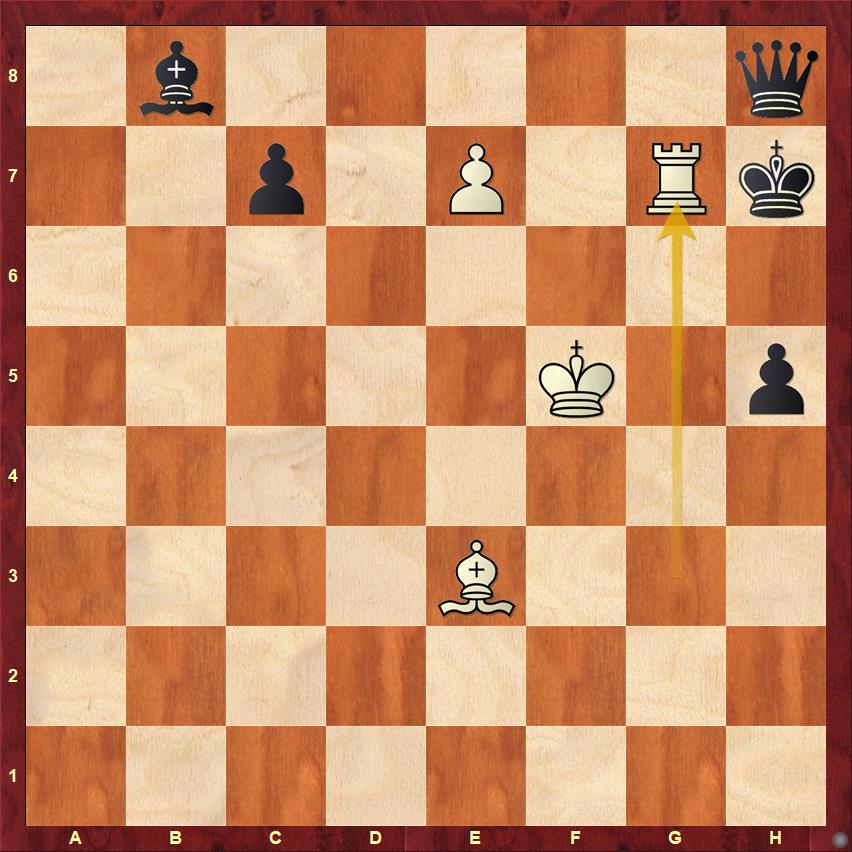
9...Qxg7 10.e8=Q is clearly a draw. So Black takes on g7 with the king, and after 9...Kxg7 10.Bd4+ Kf7 11.Bxh8 we yet again arrive at a position which completely defies intuition!
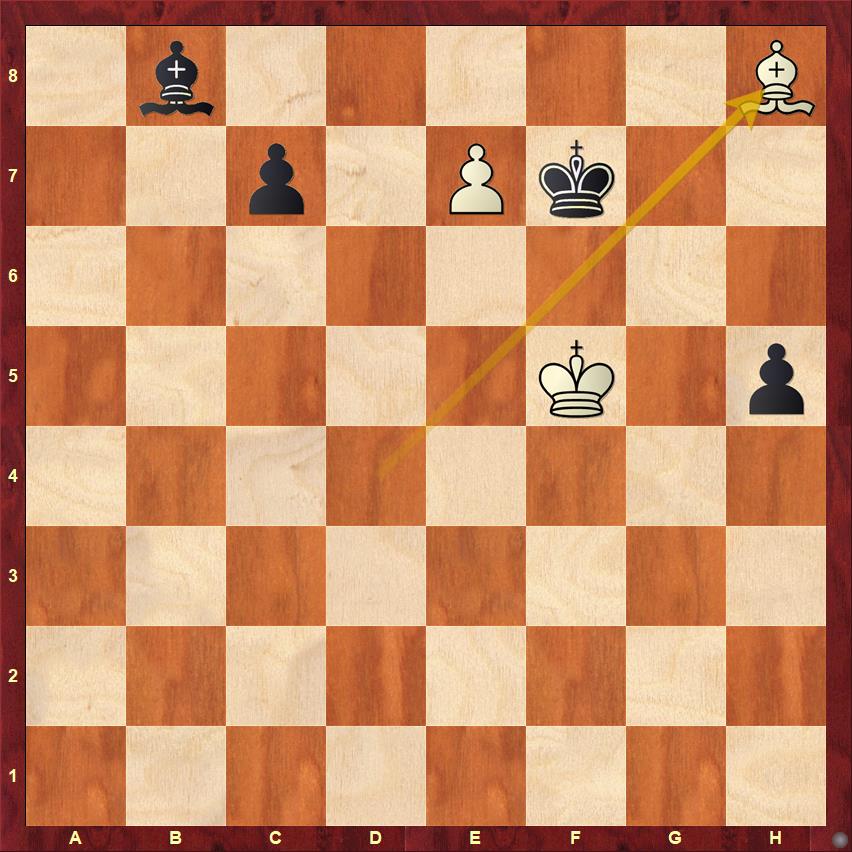
Yes, the drama is still very much on! The game continues: 11...c5 12.Bf6 Bd6 13.Ke4 Bxe7 and here comes the final trick, guess what it is?
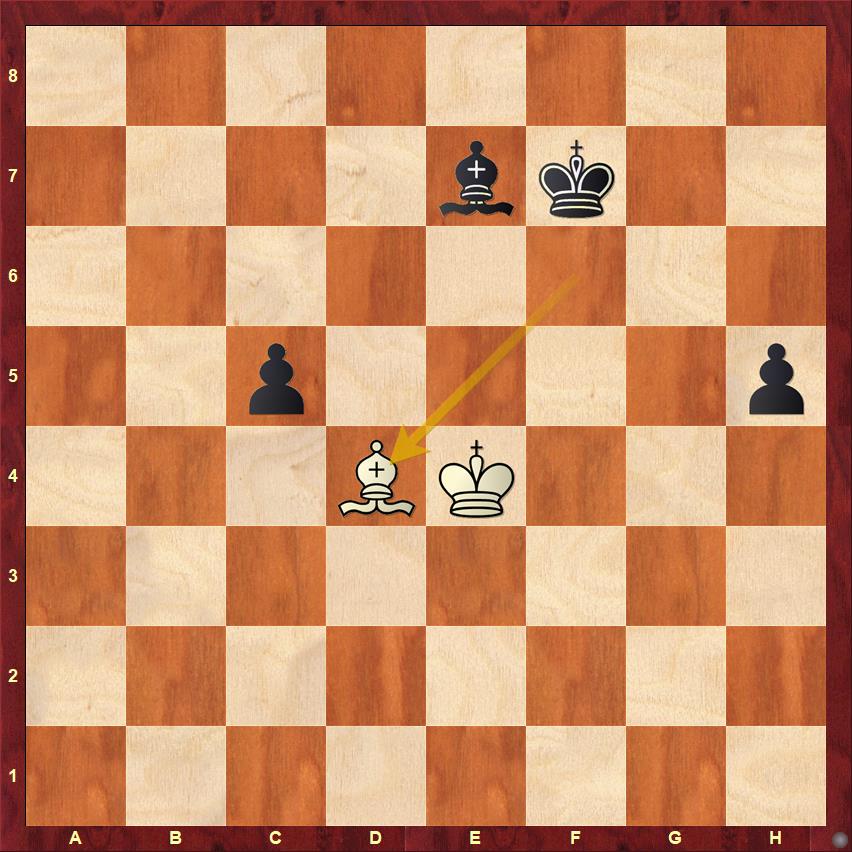
This bishop sacrifice surprisingly returns equilibrium back. Well, 14...c4 15.Kd5 h4 16.Kxc4 h3 17.Bg1 is obviously a draw and in the mainline after 14...cxd4 it turns out that the white king is just in time to stop Black's h-pawn: 15.Kxd4 h4 16.Ke3 h3 17.Kf2 h2 18.Kg2 ... No luck for Black unfortunately with the wrong coloured bishop there! And that, dear readers, is the end of the study. How breathtakingly complex! The solution is not only replete with flashy tactics but even some of the seemingly most prosaic moves conceal points of great delicacy.
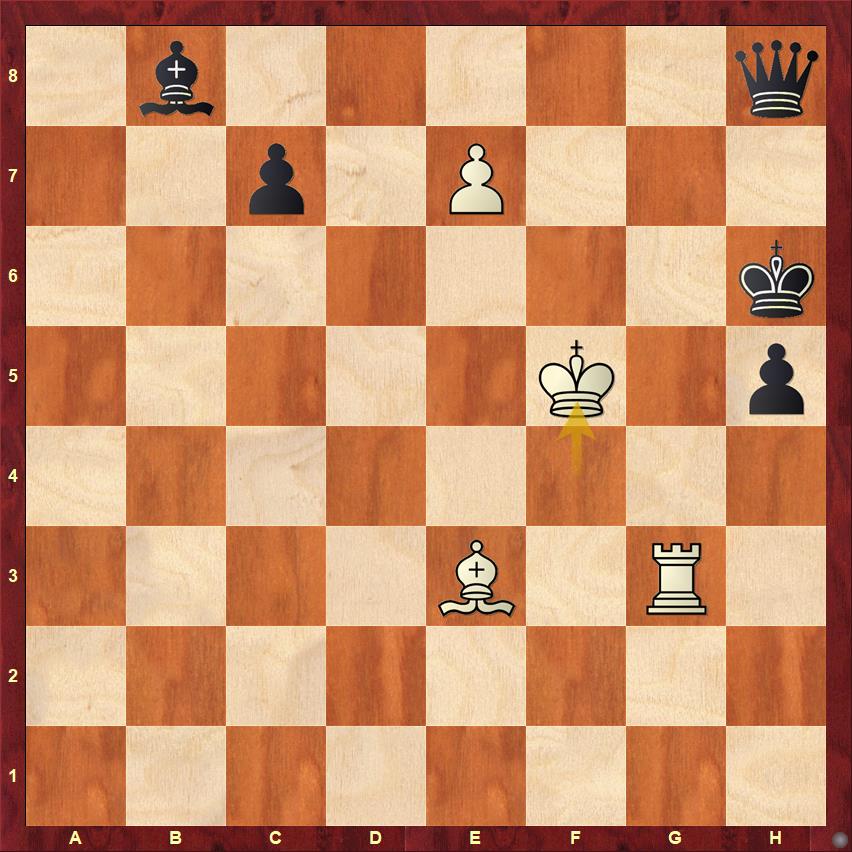
Well, the move 8.Kf5+, as simple as it may seem, is actually critical to reaching the particular drawn bishop ending (with the 14.Bd4! trick) that we have just seen. It is very important to note here that 8.Ke4+ instead of 8.Kf5+ leaves White a completely lost position with two pawns down after 8...Kh7 9.Rg7+ Kxg7 10.Bd4+ Kf7 11.Bxh8 c6. Several other nuances like this one have been rigorously analysed in the pgn below for your diligent perusal. Replay and learn. Learn and replay!
Study 5
6th UAPA 2017, Special Honourable Mention
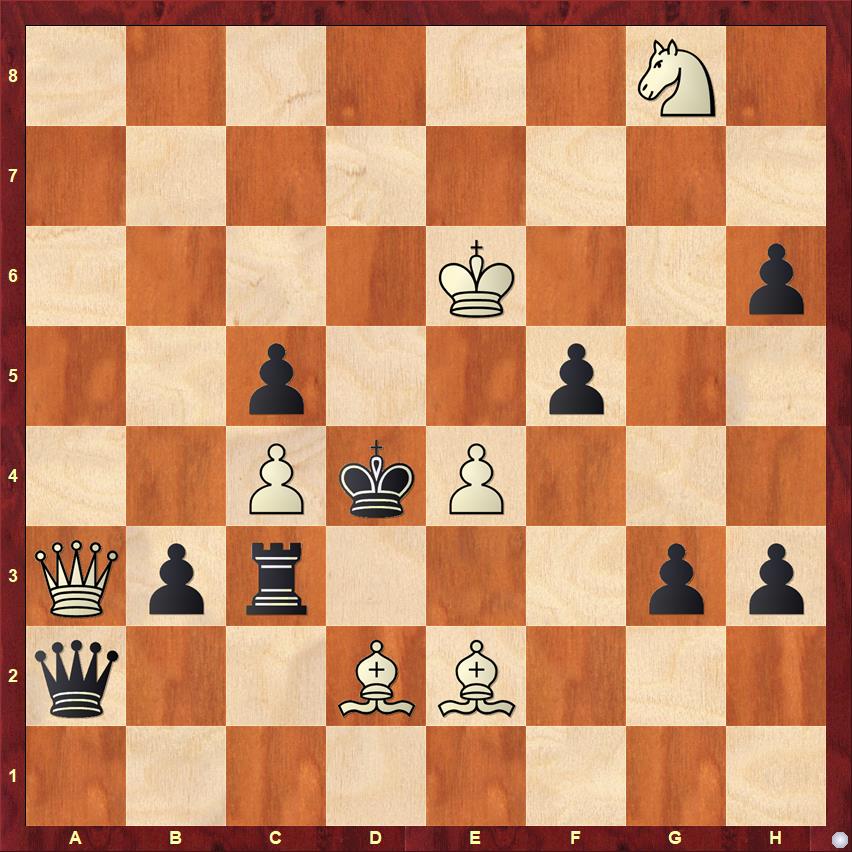
We end this section with a study that is more fun to replay than to understand ... It's a mammoth 24 moves deep task problem, and it has a logical try whose refutation too runs twenty moves deep! But no worries, the play is delightfully linear and therefore easy on the eyes. It's just a single piece that does all the work here. The action begins with 1.Ne7! threatening 2.Nc6+ Kxe4 3.Qxc5 followed by Qxf5#. Black obviously captures 1...Qxa3 and now starts the knight's cosmic dance of destruction:
2.Nxf5+ Kxe4 3.Nd6+ Kd4 4.Nb5+ Ke4 5.Nxc3+ Kd4 6.Nb5+ Ke4 7.Nd6+ (7.Nxa3? g2 draws) 7... Kd4 8.Nf5+ Ke4 9.Nxg3+ Kd4 10.Nf5+ Ke4 11.Nd6+ Kd4 12.Nb5+ Ke4 13.Nxa3 h2 14.Nb5 h1=Q 15.Nd6+ Kd4 16.Nf5+ Ke4 17.Ng3+ Kd4 18.Nxh1 b2 19.Ng3 b1=Q 20.Nf5+ Ke4 (20... Qxf5+ 21. Kxf5 Wins. No stalemate thanks to the mobile pawn on h6) 21.Nd6+ Kd4 22.Nb5+ Ke4 23.Nc3+ Kd4 24.Nxb1 1-0 In an absolutely thrilling episode the knight makes twenty-four consecutive move wrecking havoc across the board!
1.Nxh6 instead of 1.Ne7 almost works, but ultimately doesn't. The reason being precisely the absence of the h6 pawn which results in a stalemate. Here is the line:
1.Nxh6? Qxa3 2.Nxf5+ Kxe4 3.Nd6+ Kd4 4.Nb5+ Ke4 5.Nxc3+ Kd4 6.Nb5+ Ke4 7.Nd6+ Kd4 8.Nf5+ Ke4 9.Nxg3+ Kd4 10.Nf5+ Ke4 11.Nd6+ Kd4 12.Nb5+ Ke4 13.Nxa3 h2 14.Nb5 h1=Q 15.Nd6+ Kd4 16.Nf5+ Ke4 17.Ng3+ Kd4 18.Nxh1 b2 19.Ng3 b1=Q 20.Nf5+ Qxf5+ 21.Kxf5
Now over to you! Just play out the entire thing in the board below and watch all the magic unfold!
The next and final section of this article is truly the cherry on the cake. As it happens, Steffen graciously agreed to give ChessBase India a detailed interview. So what follows next will give you an insightful peek into the mind of a composer, how he thinks and works. It will also give you a perspective of different styles of composing and how they evolve. We know our chess players well, it's time that we get to know our chess composers too!
A tête-à-tête with composer Steffen S. Nielsen
_CGCRJ_400x467.jpeg)
Satanick Mukhuty (SM): I would like to start from the very beginning. How and when did you get into chess compositions? Who taught you the basics?
Steffen Nielsen (SN): I began in a chess club when I was 13. My tutor was mainly Hans Christian Andersen (yes, that is his real name). He owned the book Chess Mysteries of the Arabian Knights by Raymond Smullyan so we solved these, luckily fairly simple, retro problems together. That may well have been where my interest for chess curiosities started.
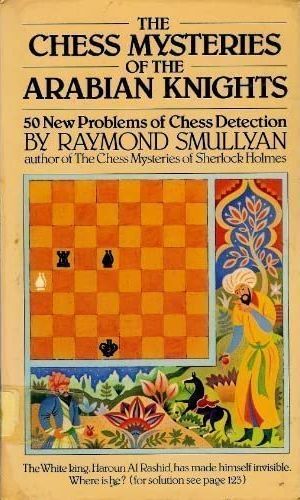
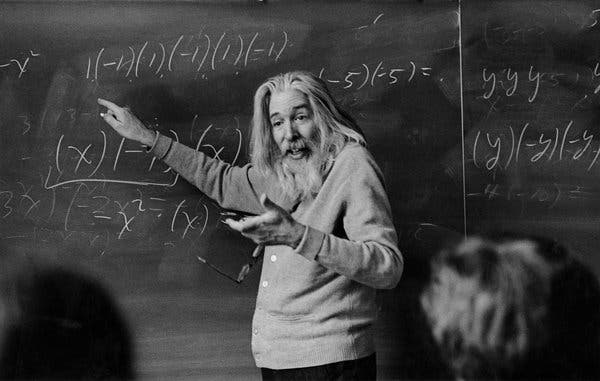
SM: It would be great if you could also tell us why you have taken up chess composition? Chess for most people means playing and competing in tournaments with other players. So I ask this question to you because the world needs to know a little more about the motivation behind composing studies and problems.
SN: In my twenties and early thirties I played a lot of chess. My rating peaked at 2244 in 2007. During that period I composed some amateurish problems and mini-studies, which were published only in club magazines. Then I became a family man. I started playing less and spent more time composing. My first study was submitted to a tournament by the British Chess Problem Society to celebrate the London 2012 Olympics. Its creation was a few years underway, but it did not win any honors. Then later that year, I won the Timman 60 JT and I was hooked for good.

SM: Tell us a bit about your professional life. You are a journalist as far as I know. How do you balance your job and passion for chess?
SN: Compared to OTB chess, composing has a great advantage that you can spend 5 minutes here and 15 minutes there. I use my phone a lot in public transport, during breaks at work (I sincerely hope that my employer is not a reader of ChessBase India!), and whenever my kids leave me a couple of minutes of silence. I must also say, that I don't know where my studies would have been today without my loving and generous wife.

SM: You won the bronze medal in the studies section of the last WCCI. It must have been a very special feeling for you. How does it feel to be one of the best in the world?
SN: The judging of studies is such a subjective matter. I see my colleague composers like Costeff and Pervakov create ambitious works that I would never be able to do. Oleg Pervakov is the greatest composer now and, in my opinion, of all time. But yes, when I hit my peak I am definitely up there among the best. That is difficult to grasp because as a regular chess player I've never had any real talent (or work ethic). I've never beaten or drawn a GM and I've only won against an IM once. And I really sucked at practical endgames, never entering them unless I was a couple of pawns up. But all of a sudden I've found my niche.
SM: Who are the composers who have influenced you the most and why? Please do quote a study (or problem) if you like!
SN: This is a difficult question. Until 10 years ago I had probably only heard of Kasparyan and knew only his super fork study with 7. g4 as well as the Reti (Kh8-g7) and Saavedra studies. So my style does not originate from any one composer. Recently I've spent a lot of time playing through the work of my predecessors and while I gained admiration for, among others, Mattison's studies, I still see no clear source of inspiration. If anything my studies is more inspired by problem themes like Novotny, unpin, crosschecks, and other line effects. My style is highly visual. Critics may even say superficial.
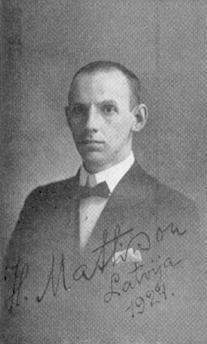
Among his predecessors, Hermann Mattison is someone whom Steffen especially admires. Mattison was a strong soviet player and during the 1920s arguably one of the best study composers. Tartakower even referred to him as the "World Champion of Study Composers". He didn't compose many studies however, his total output being less than hundred. But remarkably almost all his productions are of extremely high quality. The following is an impressive example:
Magyar Sakkvilág 1925, 1st Prize
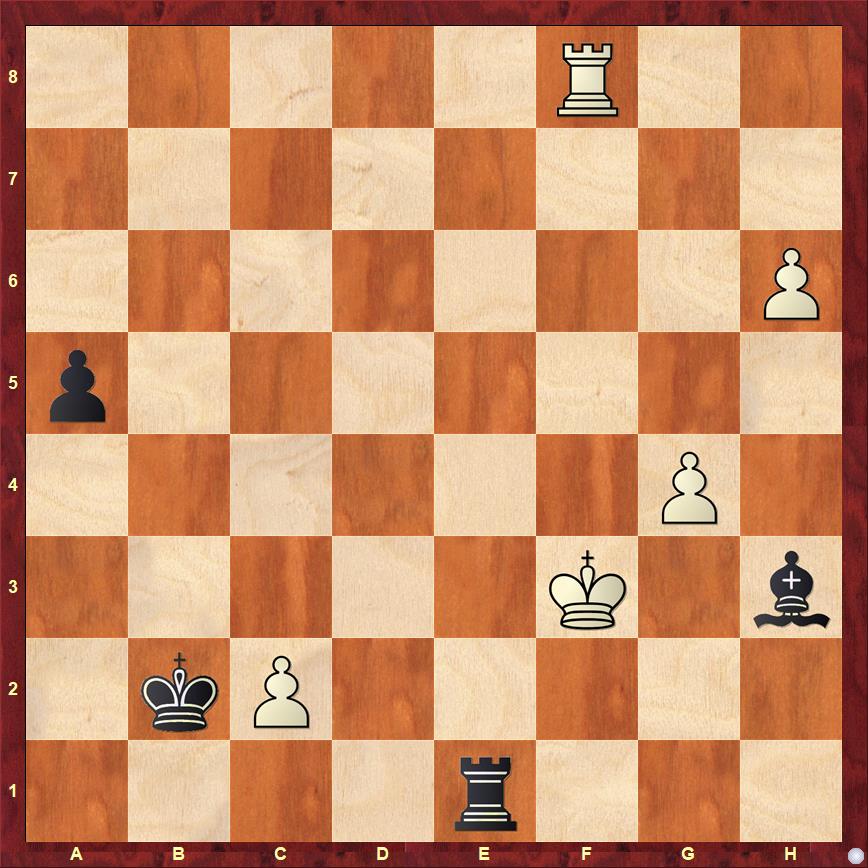
White's winning plan consists of promoting the h-pawn but this requires some daring finesse. It must start with 1.Rb8+ for 1.h7 immediately is a blunder in view of 1...Rf1+! 1...Kxc2 2.h7 Rh1 this is the best way to stop the pawn, 2...Bxg4+ 3.Kg2 Bf3+ 4.Kxf3 Rh1 5.h8=Q Rxh8 6.Rxh8 a4 7.Ra8 Kb3 8.Ke2 for instance, is a straightforward win for White. 3.Rb2+! an important move, 3.h8=Q? is an error due to 3...Bxg4+ 4.Kxg4 Rxh8 5.Rxh8 a4 6.Ra8 Kb3 which leads to a draw as wK isn't in time to catch Black's a-pawn. 3...Kc1 and now comes the showstopper 4.Rh2!! Black is forced to take 4...Rxh2 and next 5.Kg3 wins. There's no way to prevent h8=Q anymore!
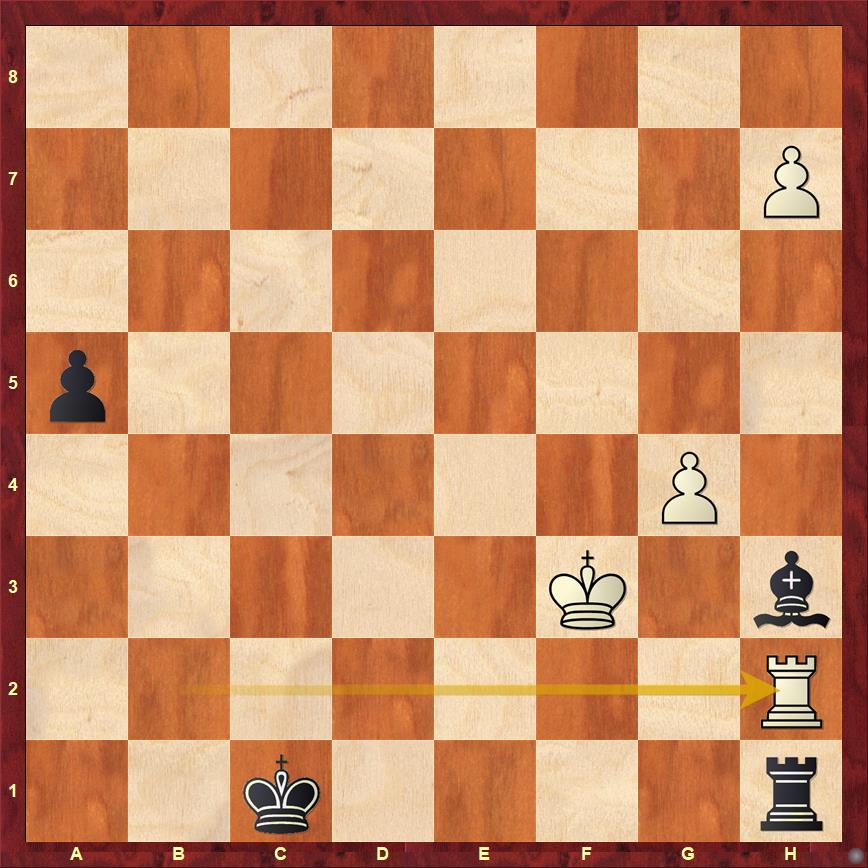
SM: I have to ask you about the study that won the first prize in Chessstar 2018 and also made into the FIDE Albums scoring 11.25 points. You posted this incredible work on Facebook where I saw it even baffled many strong GMs. Can you give us some insights on how you came up with such a deliciously complex masterpiece? How much time did it take you to compose this?
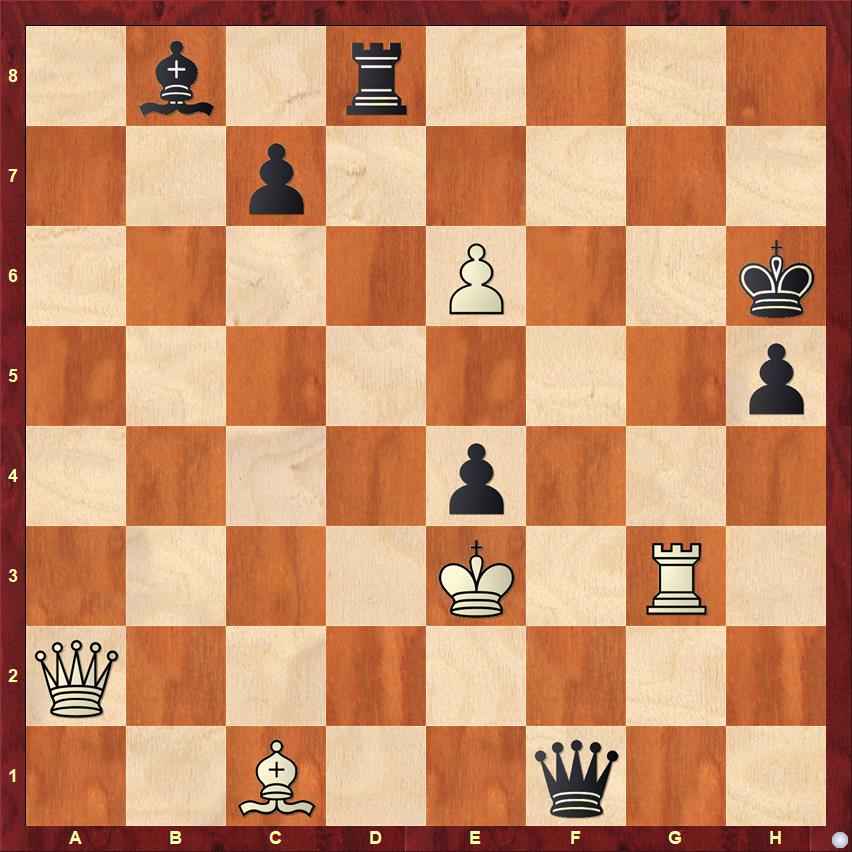
SN: This is bound to turn into a lengthy explanation. The study from Chessstar makes me very happy because it was a product of a scheme that I had been working on (on and off) for more than a year. This is a good example of my composing method. The traditional and proven composing method consists of finding a good idea and proceeding to build a fitting introduction. The end product is a study slowly building up to a dramatic climax. My method is often different. I too begin with an idea, as every study should. But my idea is typically a tactic rather than a position. The tactic may appear in the beginning, the middle, or the end of the final study. It may be played by either Black or White. It may be shifted, mirrored or changed from diagonals to ranks and files. For this study, my idea, indistinct at first, was the following. One side, here White, gives check (3.Ke5+). Black interposes a piece (3...e3). That piece is captured with a check (4.Bxe3+), but the checking piece has now entered a pin line (e1-e5). Therefore Black is able to interpose a second piece (4...Rf4), which this time cannot be captured. Somewhere during the process I realized that the second interposing move (4...Rf4) ought to be a quiet move and not the mate I had originally planned. Also somewhere along the line, I realized that this idea had the most effect if White's second checking move (4.Bxe3+) opened a line (a1-e1) resulting in a dramatic confrontation of two line-pieces. Such a confrontation creates an open-ended suspense that I really treasure. The climax occurs on the 4th move out of 18.
Such an early climax goes against all conventions of studies (and other aspects of life, I'm sure). And it puts the composer in a pickle. What if the solution peters out in an uneventful finale? I am afraid to admit so, but this is where the computer engine enters the story. The Danish writer Adam Oehlenschläger wrote of "oranges dropping into one's turban" as a metaphor for luck. Hard hopeful work and a lot of luck are needed. Here I found the additional quiet move 5.Qb2 and the double rook sac 9.Rg7. And at a point where I was already quite happy with my work, my engine friend suggested the final trick 14.Bd4. I am thrilled that GM's like this study. But something made me happier. The puzzled questions of fellow composers: "What was your original idea for this study? Was it 4...Rf4? Surely 9.Rg7+ then? Or perhaps 14.Bd4?" To this date, my three best studies (this one and Schach 2018 + Lepkiy 130 MT) were all built in this chaotic manner.


SM: What are the things that according to you make a chess problem and/or a study great?
SN: I am greatly impressed by deep problems and studies, like the masterpieces of Costeff and Pervakov. But I am not a deep composer. I am very much aiming for effect. If someone is clicking through a pgn of my study and suddenly comes to a halt because a move comes out of nowhere, I've caused the effect that I try to achieve. I think 4...Rf4 does that in the study above. I want to invent new tactics and effects. This is totally possible, by the way. We must remember that at some point someone first discovered the smothered mate, which is now part of every chess kid's weaponry. I am trying to expand this weaponry of chess combinations. My latest obsessions are unpin Novotnys and Plachuttas: A White piece arrives at an intersection square of two linear pieces simultaneously unpinning a Black piece on a third line. At a gathering of study composers, Martin Minski presented one of his studies and I remember Yochanan Afek saying, "I did not think such a thing was possible in the game of chess." This is also something I am aiming for. I want to perplex chess players who have "seen it all".
To just elucidate a little more on what Steffen means by "aiming for effect" and "deep composition" we present two studies of very contrasting type by Emilian Dobrescu. The first study is one of Steffen's favourites and is very much in line with his own style. The second one is a good illustration of "depth".
L'Italia Scacchistica 1968, 1st Prize
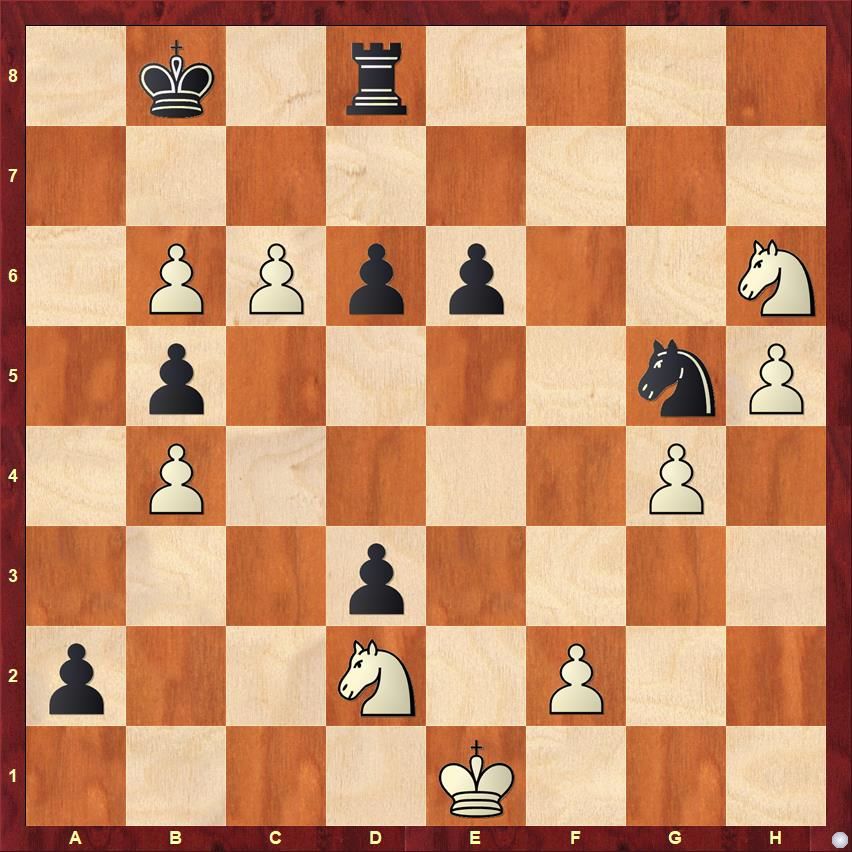
White to move and win
The play in this study is wonderfully delightful but each individual move in itself isn't really hard to understand. The struggle revolves around Black's pawn on a2 which is a move away from promoting and in the solution White sacrifices as many as three knights to neutralize it. Going over the pgn below makes it all clear.
The above study is amusing not because it has great depth but rather because it has a nice "flow". The pace and the clarity with which one move follows the next in the solution is what lends it its beguiling touch. Our next example (again by Dobrescu) is not as spectacular, however it indeed is what one would describe as "deep". It features one move in particular (an intermezzo) the logic behind which, as we will see, is not all that straightforward to discern.
L'Italia Scacchistica 1965, 3rd Prize
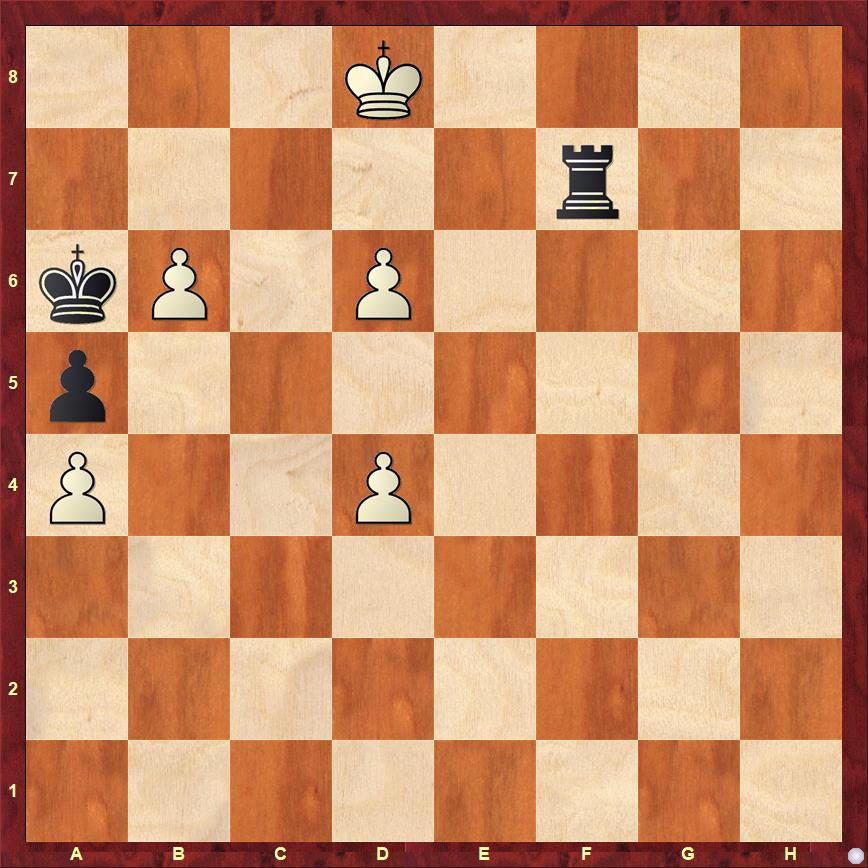
This example, by the way, is taken from Jon Levitt and David Friedgood's excellent text "The Secrets of Spectacular Chess", where they delve into aesthetic elements of chess like flow and depth in great detail. Incidentally, this study was also posed in the British Solving Championship 1993 final where curiously three GMs - John Nunn, Jonathan Mestel, and Colin McNab - failed to solve it in the allotted time limit of 35 minutes!
The solution begins with 1.d7! but things get tricky after Black's first move 1...Rf4! itself. Of course, 1...Kxb6 isn't a testing move because White wins easily in that case with 2.Ke8 Rxd7 3.Kxd7. But after 1...Rf4, the win isn't that simple. 2.Kc8 looks like a decent logical attempt but after 2...Rxd4 3.b7 Rc4+ 4.Kb8 Rb4! Black holds, 5... Rxb7+ 6.Kc8 Rb8+ 7.Kxb8 is a stalemate. 2. Kc7 Rxd4 3.b7 Rxd7+ is not going anywhere either. The key move here is actually 2.d5! - there's nothing stunning about this move but the point behind it is really well-hidden and it's the key to converting this endgame.
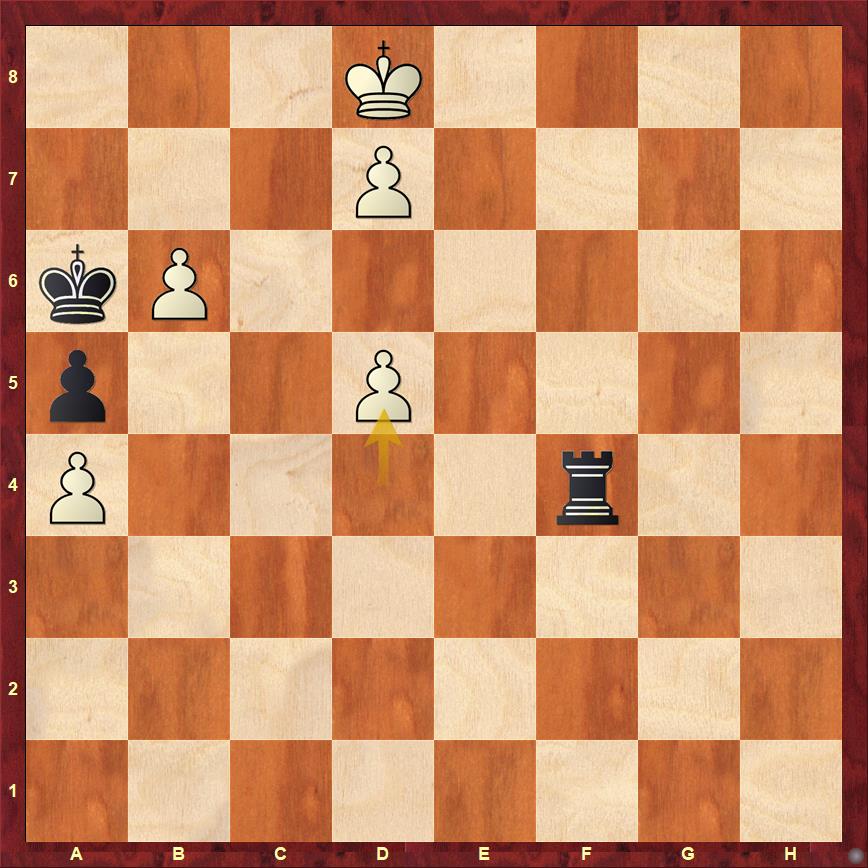
Well, the logic becomes clear with subsequent play. 3...Rxd5 4.b7 Rc5+ 5.Kb8 and now we see the point: the black rook can't go to the b-file anymore as the b5 square is covered by wPa4! 2.d5! was therefore a decoy in disguise. Simple yet hard to grasp.

The play continues 6.Ka8 Rxd7 7.b8=N+! (7.b8=Q?? Rd8 8.Qxd8 stalemate) 7...Kb6 8.Nxd7+ Kc6 9.Ne5+ Kc5 10.Nd3+ Kc4 11.Nb2+ Kb3 12.Ka7 Kxb2 13. Ka6 and White wins!
SM: I have seen you taking interest in genres other than studies. You have composed a couple of fairy problems as well. Do you consider specializing in a new field in the future?
SN: Apart from studies, I am especially fond of helpmates, and I will surely compose more helpmates in the future. But to be honest there are so many great composers in the other genres. Amazing logical and mathematical minds. I am in awe when I think about what, for instance, Michel Caillaud has accomplished across genres. When I see the complex creations these minds are able to make work, I am not sure a few line effects from me will make an impact in, for instance, helpmates.

SM: You have composed a good number of masterpieces with your good friend Martin Minski. In over the board chess coaches and seconds collaborate with players. How does the process of collaboration in composing work in general?

SN: My collaboration with Martin takes place ninety-nine percent online. We send back versions on chat and email. Luckily we agree on the basics, so whenever we disagree it is about minor details. The main trick is to remain open to ideas of the other person and not be too dogmatic. If you set out to make sure that all pieces must move during the solution, or that the final product must have a specific form, creativity is hampered. Pragmatism is the greatest asset of our collaboration in my view. Martin has great ideas but also a great feeling for what is possible and what is not. I spend weeks on studies that I fail to make work, and Martin will either spent an hour convincing himself (and eventually me) that it cannot be done or just as often he will spend one day making it work!

This article would certainly remain incomplete without quoting a couple of amazing Nielsen-Minski coproductions...So here goes our pick!
Kekely 60 JT 2019, 3rd Honourable Mention
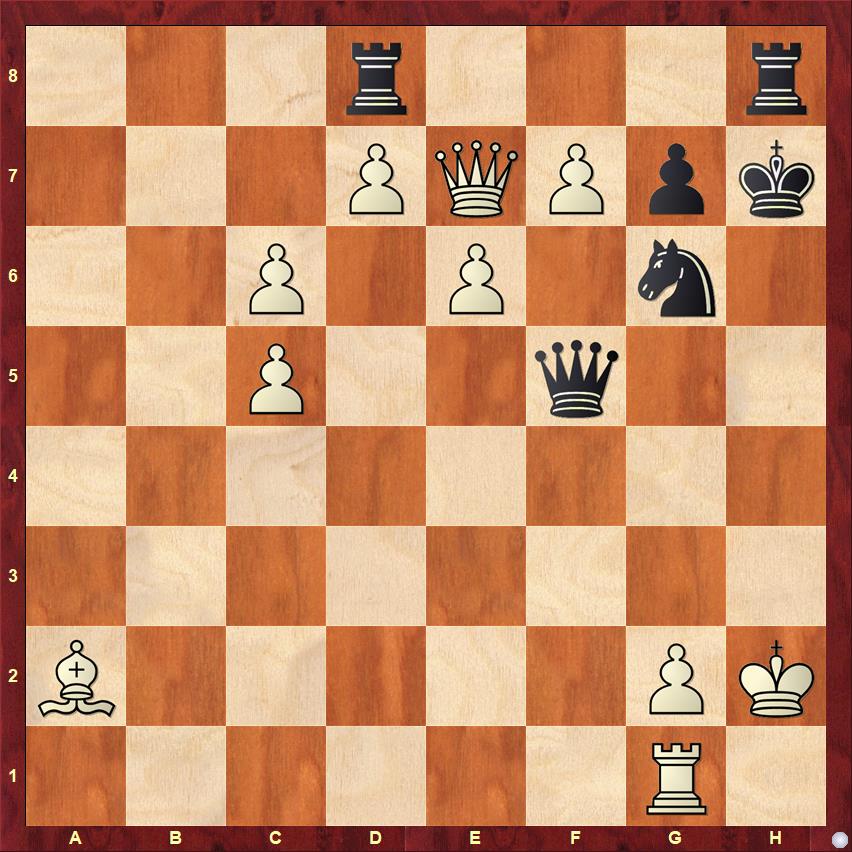
A crazy tactical study where White starts off with an audacious queen sacrifice and then goes for some surreal underpromotions to ensure stalemate avoidance! 1.Qh4+ Nxh4 2.Bb1 White too goes after Black's queen 2...Kg6 3.c7 and now there are two continuations:
(a) 3...Qe4 in this case White goes 4.cxd8R!! - the first underpromotion. Note that 4.Bxe4 is out of question as Black has 5.Nf5# and 4.cxd8=Q? too is a mistake because of 4...Nf5+ 5.Qxh8 Qh4+ 6.Qxh4 pin-stalemate! So the mainline continues 4...Rh6 5.Rh8 Rxh8 6.f8=R! (and not 6...d8=R? which fails to 6...Rh6!) 6...Nf5+ 7.Rxh8 Qh4+ 8.Rxh4 and White wins, no stalemate this time!
(b) The second possibility is 3...Qd3 and in this case we have a similar variation but with a slight thematic change: 4.cxd8=R!! Rh6 5.Rh8 Rxh8 6.d8=R! (important to not play 6.f8=R? instead, in which case Black equalizes with 6...Rh6!) 6...Nf5+ 7.Rxh8 Qg3+ 8.Kh1 Qh4+ 9.Rxh4 winning, and once again the underpromotion ensures that stalemate is avoided. 4.cxd8=Q? doesn't work obviously because of 4...Nf5+ 5.Qxh8 Qg3+ 6.Kh1 Qh4+! 7.Qxh4 leading to the exactly same pin-stalemate. A lively study with harmonious echo of ideas in two mainlines!
Mircea Pavlov 80 JT 2017, 1st Prize
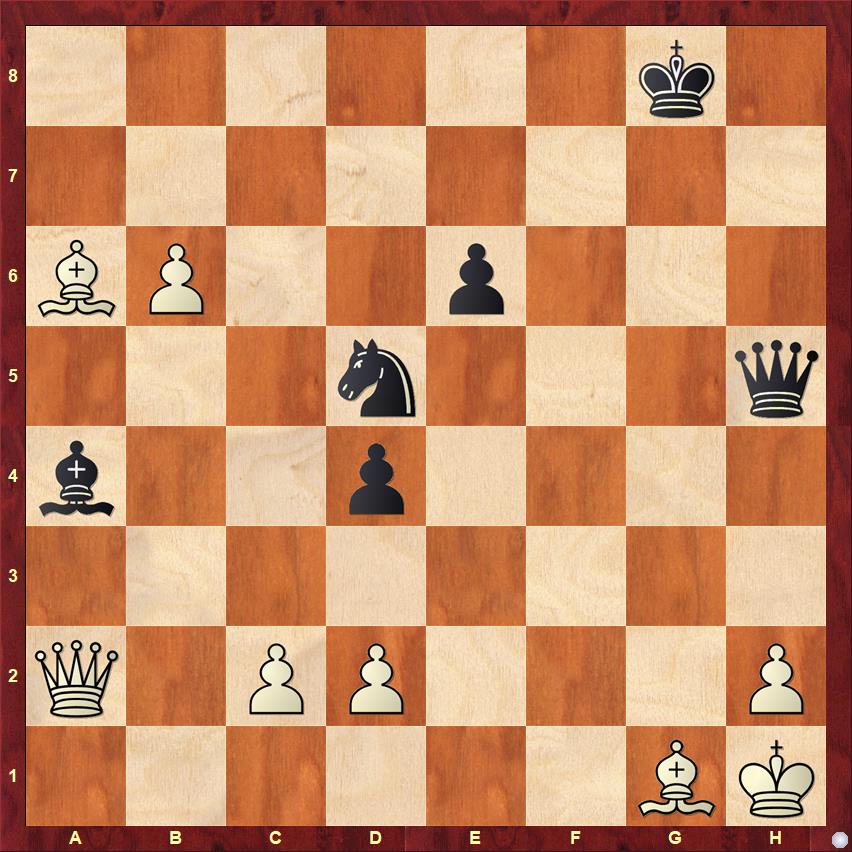
This next study is very much the same in spirit to the first one but only more intense. The solution begins with 1.Bf1, note that 1.Qxa4 isn't possible because of 1...Qf3#, Black is down two pawns but can create threats along the weak a8-h1 diagonal. 1...Nf4 2.Bg2, and now the play bifurcates into two distinct continuations:
(a) 2...Qe2! Black intends to deflect the white light squared bishop from the a8-h1 diagonal 3.Bb7 Qa6!! deflection! 4.Bxa6 isn't possible because of 4...Bc6+ followed by mate. So White counters with a queen sacrifice of its own: 4.Qd5!! blocking the diagonal!
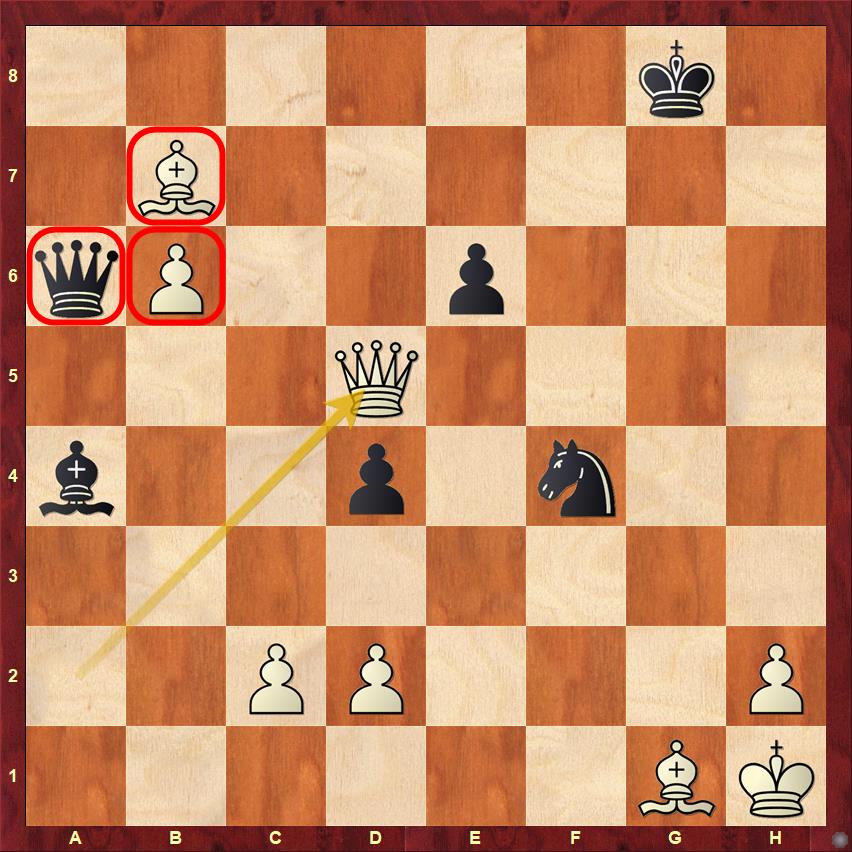
The line further continues 4...Nxd5 5.Bxa6 Bc6 6.Bb5 Bb7 7.Bxd4 Nc7+ (does Black regain material here? Well, not exactly...) 8.Kg1 Nxb5 9.Bc5 and it all ends with a striking final position where the black knight is unexpectedly dominated.
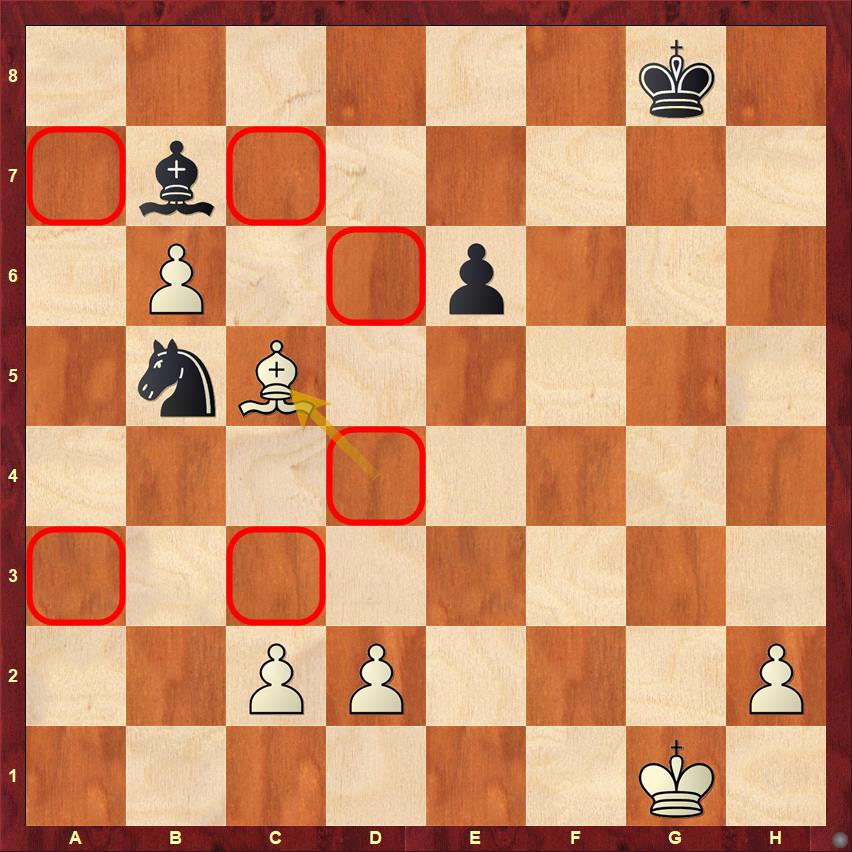
On b5 the luckless black knight is caught between the proverbial scylla and charybdis, and that is how White manages to keep the material advantage intact. Black doesn't really win an extra piece with 8...Nxb5 as the very next move 9.Bc5 leaves the black knight completely trapped. Now simply 10.c4 followed by the capture of the immured knight will happen next and that will leave White with three extra pawns and a completely winning position!
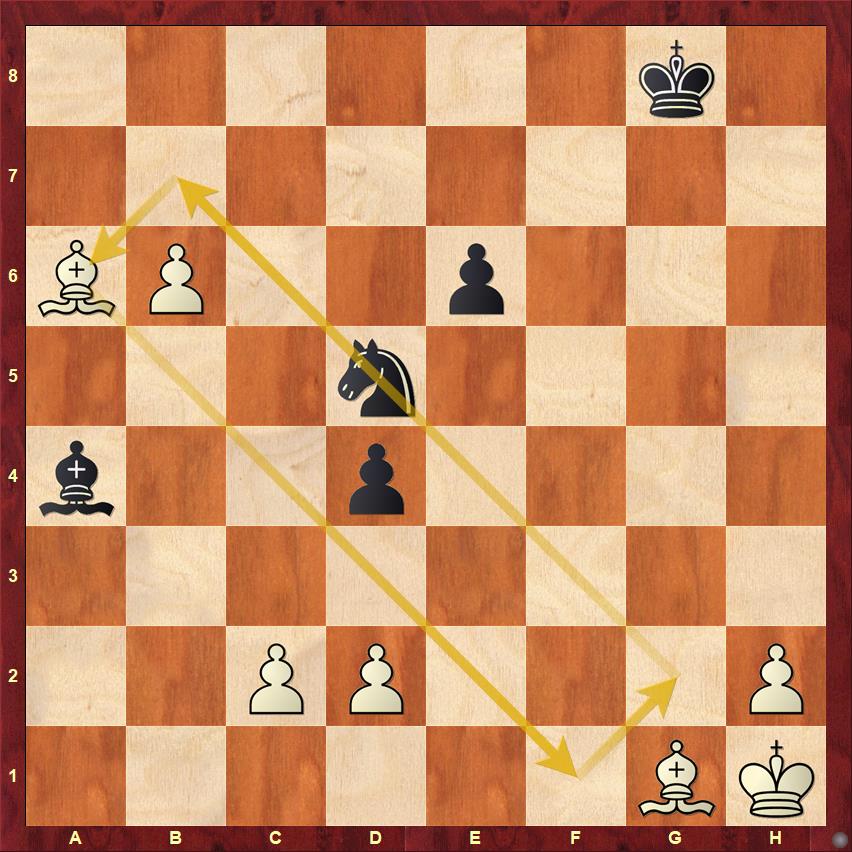
(b) The second variation is even more direct with Black sacrificing the queen right away, White however defends analogously: 2...Qh3!! 3.Qd5!! Steffen and Martin are from a different planet where chess players are very eager to give away their queens!
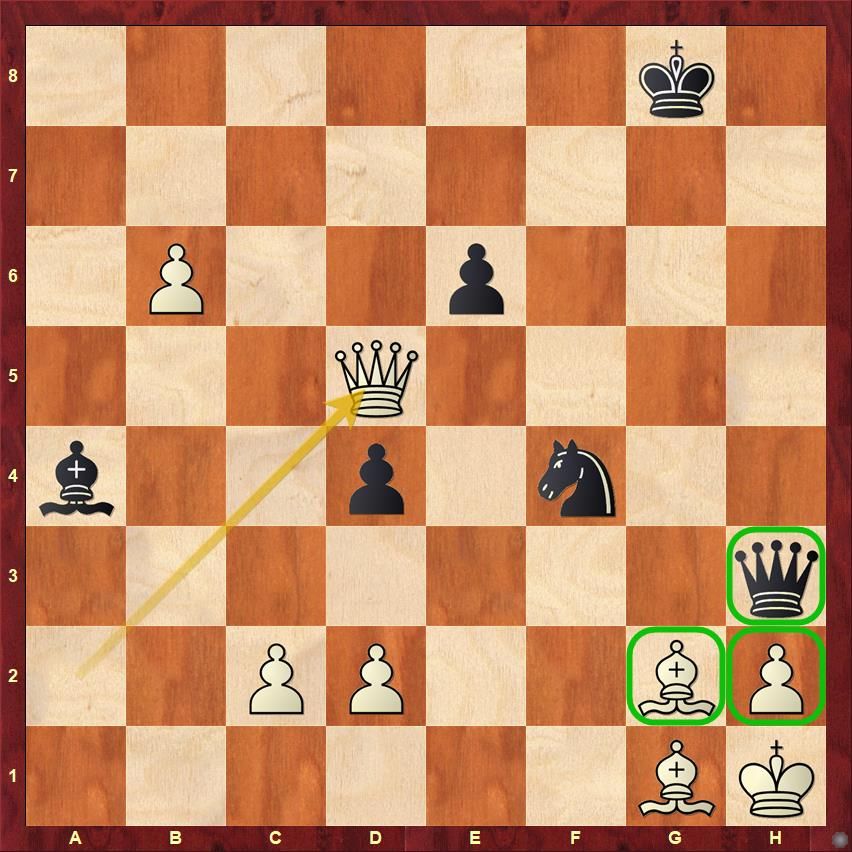
The rest of the moves are simple enough: 3...exd5 4.Bxh3 Nxh3 5.b7 and wins! A perfect geometric garnet! Replay it in full below with all the analysis:
SM: My final question: Do you have a dream study? An idea that you would really want to achieve some day, that perhaps would be hailed as your magnum opus by posterity?
SN: I've thought about this for some time, actually. I have a dream about the perfect king hunt study. Like Kasparov - Topalov, Wijk Aan Zee 1999 or Averbakh - Kotov, Zurich 1953 (30...Qxh3!!) just much crazier. It must start off with a queen sacrifice in a realistic middle game position. The Black king is forced deep into White's position. But there is no immediate mate. Instead White must make a quiet move allowing Black pieces to come to the rescue, giving back some of his material surpluses. After several twists and turns, we now have an endgame with equal material where White decides matters with a deep quiet move... For now, I am nowhere near succeeding in this. Which is why it is a dream study, I guess!
ChessBase India thanks Steffen for having this perceptive conversation. No wonder he frequently seeks inspiration from the "real" (over-the-board games) to build his own world of "fiction" (art). This interesting interaction between art and reality in chess composition can perhaps be a topic of another article for another day. For now however we bring part I of "Giants of Modern Studies" to a close. Do stay tuned for the second part though which will be an exclusive feature on none other than the Vice World Champion of study composing Martin Minski...
About the author

Satanick Mukhuty is an author and social media manager at ChessBase India. He has a background in Mathematics. He is an avid enthusiast of composition chess and is sincerely committed to promoting it around the world.





